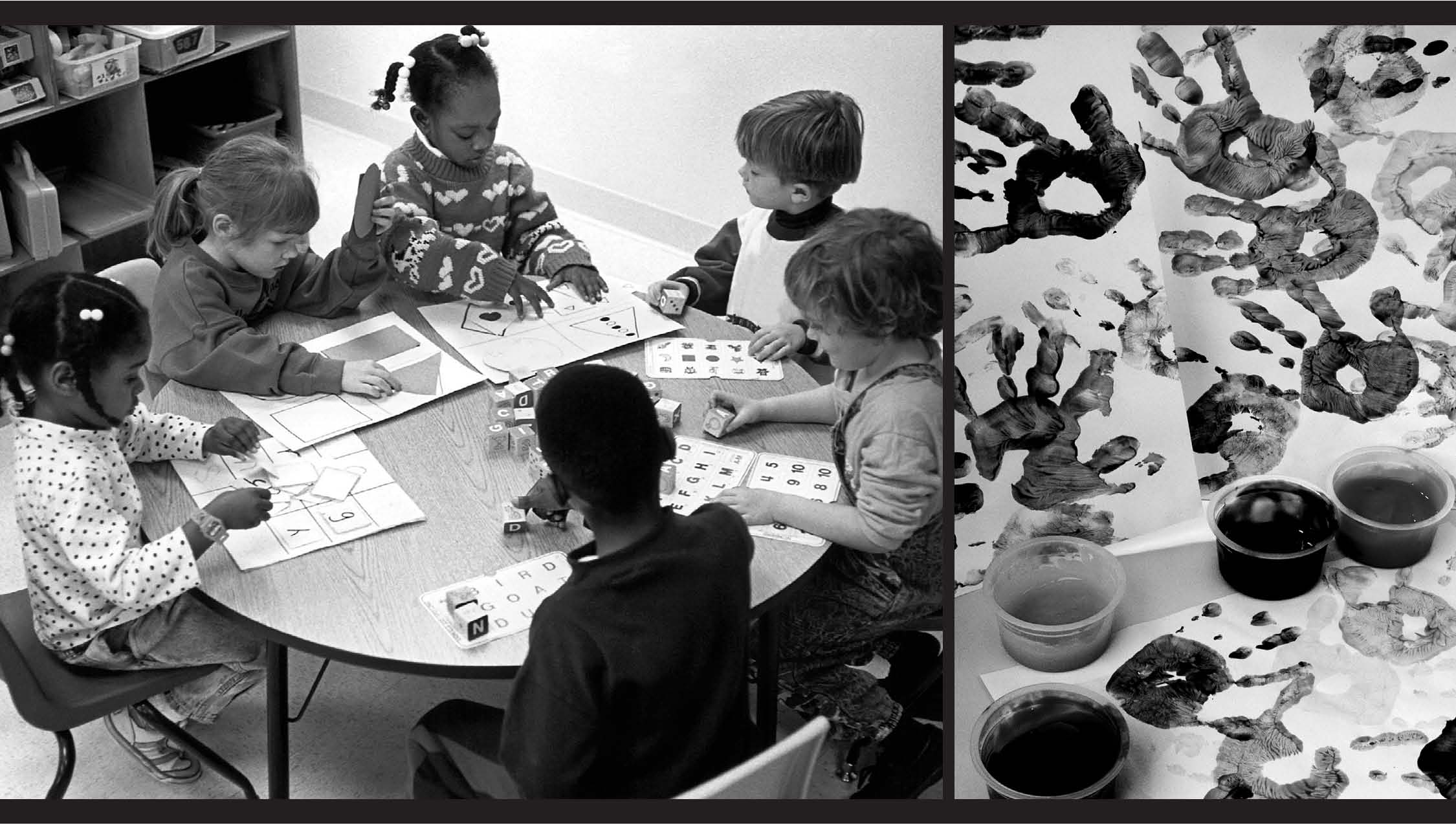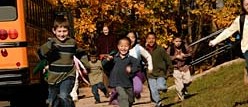NHES Screeners and Questionnaires
2012 National Household Education Survey (NHES 2012) Full Scale Data Collection
Appendix B NHES 2012 Questionnaires
NHES Screeners and Questionnaires
OMB: 1850-0768
Appendix B.
NHES: 2012 Questionnaires
Screener Questionnaires
Without name*,
With name*,
Topical Questionnaires
Early Childhood Program Participation*,
Early Childhood Program Participation – short form for 4th mailing
Parent and Family Involvement in Education – Enrolled Students*,
Parent and Family Involvement in Education – Homeschooled Students*,
Parent and Family Involvement in Education – Enrolled Short Form for 4th mailing
* A Spanish version will be created after OMB approval.
The Census version will be created after OMB approval and will differ only in cover design from the questionnaires shown in this appendix.
Screener Questionnaire Without Name
Commonly Asked Questions
Q: How did you get my address?
A: Your address was randomly selected from among all of the home addresses in the nation. It was selected using scientific sampling methods to represent other households in the U.S.
Q: Why don’t you ask more questions about education in this questionnaire?
A: The purpose of this questionnaire is to find out if anyone in your household is eligible for the next stage of the survey. If so, we will send a second questionnaire that will ask about educational experiences of a member of your household.
Q: If there are no children or anyone currently in school in my household, should I respond?
A: Yes, you should respond to this survey. Once you return the questionnaire, the study will be able to see if anyone in your household is eligible for the next and final survey. If no one is eligible, you will not receive another survey.
Q: Why should I take part in this study? Do I have to do this?
A: This survey is the only way that the Department of Education can learn about children’s care, early learning activities, and schooling from your perspective. You represent thousands of other households like yours, and you cannot be replaced. Your answers and opinions are very important to the success of this study. You may choose not to answer any or all questions in this survey. In order for the survey to be representative it is important that you complete and return this questionnaire. Those who do not return the survey will not be represented in key statistics used by policymakers and researchers.
Q: How will the information I provide be used? Will my privacy be protected?
A: Your responses will be combined with those of others to produce statistical summaries and reports. Your individual data will not be reported. Your answers may be used only for statistical purposes and may not be disclosed, or used, in identifiable form for any other purpose except as required by law (Section 9573, 20 US Code).
Q: How much time will it take?
A: On average, it should take 3 minutes for you to respond, including the time for reviewing instructions and completing and reviewing the collection of information.
Q: Who is sponsoring the study? Is this study conducted by the Federal Government?
A: The National Center for Education Statistics, within the Department of Education, is authorized to conduct this study (Section 9543, 20 US Code). This study has been approved by the Office of Management and Budget, the office that reviews all federally sponsored surveys. The approval number assigned to this study is XXXX-XXXX. You may send any comments about this survey, including its length, to the Federal Government. Write to: Andrew Zukerberg, National Center for Education Statistics, U.S. Department of Education, 1990 K Street NW, Room 9036, Washington, DC 20006-5650. You may send e-mail to XXX. If you have any questions about the study, contact XXX toll-free at 1-xxx-xxx-xxxx.
OMB No. XXXX-XXXX: Approval Expires XX/XX/XXXX

National Household Education Survey






The National Center for Education Statistics is authorized to conduct this survey under Section 9543, 20 US Code. Your participation is voluntary. Your answers may be used only for statistical purposes and may not be disclosed, or used, in identifiable form for any other purpose except as required by law (Section 9573, 20 US Code). The information you provide will be combined with information from other participants to produce statistical summaries and reports. |

Start
Here |
|
► Start with the youngest youth or child who is age 20 or younger. |
Youth / Child 1 ▼ |
Youth / Child 2 ▼ |
Youth / Child 3 ▼ |
Youth / Child 4 ▼ |
Youth / Child 5 ▼ |
The Department of Education is studying households with youth or children age 20 or younger. Each household is different, and we need your response so we can send you a survey that is right for your household. ► Return this form even if there are no youth or children in this household after marking the correct box in item 1. ► This survey should be filled out by an adult household member living at this address. ► Please use a blue or black pen if available. 1. Are there any youth or children age 20 or younger living in this household? Do not include those living in college housing.
2. How many youth or children age 20 or younger live in this household? |__|__| number age 20 or younger ► Continue answering questions 3 through 6 for each youth or child living in this household. |
|
||||||
|
3. How old is this child in years? |
|__|__| age in years |
|__|__| age in years |
|__|__| age in years |
|__|__| age in years |
|__|__| age in years |
|
|
4. What is this child’s sex? |
|
|
|
|
|
|
|
5. Is this child currently in Mark [X] ONE only. |
G |
G |
G |
G |
R |
|
|
6. What is this child’s current grade or equivalent? |
write |__|__| grade 1 through 12
|
write |__|__| grade 1 through 12
|
write |__|__| grade 1 through 12
|
write |__|__| grade 1 through 12
|
write |__|__| grade 1 through 12
|
|
|
► Please verify you have listed the 5 youngest youth or children living in this household in columns 1 through 5 above. |
||||||
|
|
|
|
|
|
||
A If you marked in question 1 that no one in your household is age 20 or younger, please stop here and return this survey to us in the enclosed envelope. It is important that we receive a response from every household selected for this study. Thank you for your time. |
|
|
► Thank you. Please return this form in the postage-paid envelope provided or mail it to: National Household Education Survey
Toll-free number for questions: 1-XXX-XXX-XXXX |
||||
|
|
|
|
|
|
|
|
Screener Questionnaire With Name
Commonly Asked Questions
Q: How did you get my address?
A: Your address was randomly selected from among all of the home addresses in the nation. It was selected using scientific sampling methods to represent other households in the U.S.
Q: Why don’t you ask more questions about education in this questionnaire?
A: The purpose of this questionnaire is to find out if anyone in your household is eligible for the next stage of the survey. If so, we will send a second questionnaire that will ask about educational experiences of a member of your household.
Q: If there are no children or anyone currently in school in my household, should I respond?
A: Yes, you should respond to this survey. Once you return the questionnaire, the study will be able to see if anyone in your household is eligible for the next and final survey. If no one is eligible, you will not receive another survey.
Q: Why should I take part in this study? Do I have to do this?
A: This survey is the only way that the Department of Education can learn about children’s care, early learning activities, and schooling from your perspective. You represent thousands of other households like yours, and you cannot be replaced. Your answers and opinions are very important to the success of this study. You may choose not to answer any or all questions in this survey. In order for the survey to be representative it is important that you complete and return this questionnaire. Those who do not return the survey will not be represented in key statistics used by policymakers and researchers.
Q: How will the information I provide be used? Will my privacy be protected?
A: Your responses will be combined with those of others to produce statistical summaries and reports. Your individual data will not be reported. Your answers may be used only for statistical purposes and may not be disclosed, or used, in identifiable form for any other purpose except as required by law (Section 9573, 20 US Code).
Q: How much time will it take?
A: On average, it should take 3 minutes for you to respond, including the time for reviewing instructions and completing and reviewing the collection of information.
Q: Who is sponsoring the study? Is this study conducted by the Federal Government?
A: The National Center for Education Statistics, within the Department of Education, is authorized to conduct this study (Section 9543, 20 US Code). This study has been approved by the Office of Management and Budget, the office that reviews all federally sponsored surveys. The approval number assigned to this study is XXXX-XXXX. You may send any comments about this survey, including its length, to the Federal Government. Write to: Andrew Zukerberg, National Center for Education Statistics, U.S. Department of Education, 1990 K Street NW, Room 9036, Washington, DC 20006-5650. You may send e-mail to XXX. If you have any questions about the study, contact XXX toll-free at 1-xxx-xxx-xxxx.
OMB No. XXXX-XXXX: Approval Expires XX/XX/XXXX

National Household Education Survey






The National Center for Education Statistics is authorized to conduct this survey under Section 9543, 20 US Code. Your participation is voluntary. Your answers may be used only for statistical purposes and may not be disclosed, or used, in identifiable form for any other purpose except as required by law (Section 9573, 20 US Code). The information you provide will be combined with information from other participants to produce statistical summaries and reports. |

Start
Here |
|
► Start with the youngest youth or child who is age 20 or younger.
|
Youth / Child 1 ▼ |
Youth / Child 2 ▼ |
Youth / Child 3 ▼ |
Youth / Child 4 ▼ |
Youth / Child 5 ▼ |
||||||||||||||||||||||||||||||||||||||||
The Department of Education is studying households with youth or children age 20 or younger. Each household is different, and we need your response so we can send you a survey that is right for your household. ► Return this form even if there are no youth or children in this household after marking the correct box in item 1. ► This survey should be filled out by an adult household member living at this address. ► Please use a blue or black pen if available. 1. Are there any youth or children age 20 or younger living in this household? Do not include those living in college housing.
2. How many youth or children age 20 or younger live in this household? |__|__| number age 20 or younger ► Continue answering questions 3 through 7 for each youth or child living in this household. |
|
3. What is his or her first name, initials, or nickname? First names will be used only to ask you questions about the education of a specific child. |
First name/initials/nickname |
First name/initials/nickname |
First name/initials/nickname |
First name/initials/nickname |
First name/initials/nickname |
||||||||||||||||||||||||||||||||||||||||
|
4. How old is this child in years? |
|__|__| age in years |
|__|__| age in years |
|__|__| age in years |
|__|__| age in years |
|__|__| age in years |
|||||||||||||||||||||||||||||||||||||||||
|
5. What is this child’s sex? |
|
|
|
|
|
|||||||||||||||||||||||||||||||||||||||||
|
6. Is this child currently in Mark [X] ONE only. |
G |
G |
G |
G |
R |
|||||||||||||||||||||||||||||||||||||||||
|
7. What is this child’s current grade or equivalent? |
write |__|__| grade 1 through 12
|
write |__|__| grade 1 through 12
|
write |__|__| grade 1 through 12
|
write |__|__| grade 1 through 12
|
write |__|__| grade 1 through 12
|
|||||||||||||||||||||||||||||||||||||||||
|
► Please verify you have listed the 5 youngest youth or children living in this household in columns 1 through 5 above. |
||||||||||||||||||||||||||||||||||||||||||||||
|
|
|
|
|
|
||||||||||||||||||||||||||||||||||||||||||
A If you marked in question 1 that no one in your household is age 20 or younger, please stop here and return this survey to us in the enclosed envelope. It is important that we receive a response from every household selected for this study. Thank you for your time. |
|
|
► Thank you. Please return this form in the postage-paid envelope provided or mail it to: National Household Education Survey
Toll-free number for questions: 1-XXX-XXX-XXXX |
||||||||||||||||||||||||||||||||||||||||||||
ECPP Questionnaire
The National Household Education Survey
Our Children’s Future: A Survey of Young Children’s Care and Education

Thank you for helping us with this survey. Based on the information we received from your household in your last survey, we’re asking you to complete this final step.

S
U.S.
Department of Education
National
Center for Education Statistics
Instructions
Please answer all the survey questions thinking about this child or youth.
|
We are authorized to collect this information by Section 9543, 20 U.S. Code. You do not have to provide
the information requested. However, the information you provide will help the Department of Education’s ongoing efforts to learn more about the educational experiences of children and families. There are no
penalties should you choose not to participate in this study. Your answers may be used only for statistical
purposes and may not be disclosed, or used, in identifiable form for any other purpose except as required
by law (Section 9573, 20 U.S. Code). Your responses will be combined with those from other participants
to produce summary statistics and reports.
This survey is estimated to take an average of 20 minutes, including time for reviewing instructions and
completing and reviewing the collection of information. An agency may not conduct or sponsor, and a
person is not required to respond to, a collection of information unless it displays a currently valid OMB
control number. Send comments regarding this burden estimate or any other aspect of this collection of
information, including suggestions for reducing this burden, to: Andrew Zukerberg, National Center for
Education Statistics, U.S. Department of Education, 1990 K Street NW, Room 9036, Washington, DC
20006-5650. Do not return the completed form to this address.
1 |
► Thank you for your help with the previous survey your household completed.
► Answer all the survey questions thinking about the child listed below:
► Care Your Child Receives from Relatives
![]() These
questions ask about different types of child care this child may
now receive on a regular
basis
from someone other than his/her parents or guardians.
These
questions ask about different types of child care this child may
now receive on a regular
basis
from someone other than his/her parents or guardians.
1. Is this child now receiving care from a relative other than a parent or guardian on a regular basis, for example, from grandparents, brothers or sisters, or any other relatives?
N

GO TO question 17
oY
 es
es
2. Are any of these care arrangements regularly scheduled at least once a week?
N

GO TO question 17
oY
 es
es
3. These next questions are about the care that this child receives from the relative who provides the most care. How is that relative related to this child?
M ark
ONE
only.
ark
ONE
only.
Grandmother/Grandfather
Aunt /Uncle
Brother /Sister
Another relative
4 . How
old is the relative who provides the most care to this child?
. How
old is the relative who provides the most care to this child?

age
5. Is this care provided in your home or another home?
Own home
Other home
Both
6. How many days each week does this child receive care from this relative?
| __|
days each week
__|
days each week
7. How many hours each week does this child receive care from this relative?
| __|__|
hours each week
__|__|
hours each week
8. How old was this child in years and months when this particular regular care arrangement with this relative began?
|
 __
years months
__
years months
9. What language does this relative speak most when caring for this child?
English
Spanish
A language other than English or Spanish
English and Spanish equally
English and another language equally
1 0. Will
this relative care for this child when the child is…
0. Will
this relative care for this child when the child is…
|
|
No ▼ |
Yes ▼ |
a. |
Sick but does not have a fever? |
|
|
b. |
Sick and has a fever? |
|
|
11. Is there any charge or fee for the care this child receives from this relative, paid either by you or some other person or agency?
N

GO TO question 15
oY
 es
es
12. Do any of the following people, programs, or organizations help pay for this relative to care for this child?
M ark
ONE box for each item below.
ark
ONE box for each item below.
|
|
No ▼ |
Yes ▼ |
a. |
A relative of this child outside your household who provides money specifically for that care, not including general child support |
|
|
b. |
Temporary Assistance for Needy Families, or TANF |
|
|
c. |
Another social service, welfare, or child care agency |
|
|
d. |
An employer, not including a tax-free spending account for child care |
|
|
e. |
Someone else |
|
|
1 3. How
much does your household pay for this relative to care for this
child, not counting any money that may be received from others to
help pay for care?
3. How
much does your household pay for this relative to care for this
child, not counting any money that may be received from others to
help pay for care?
Write ‘0’ if your household does not pay this relative for care.



 $
.00
$
.00
Is that amount per…
Hour
Day
Week
Month
Year
Every 2 weeks
O

 ther
Specify:
ther
Specify:
14. How many children from your household is this amount for, including this child?
This child only
2 children
3 children
4 children
5 or more children
15. Does this child have any other care arrangements with a relative on a regular basis?
N

GO TO question 17
oY
 es
es
16. How many total hours each week does this child spend in those other care arrangements with relatives?
| __|_
hours each week
__|_
hours each week
► Care
Your Child Receives from Non-relatives
Care
Your Child Receives from Non-relatives
![]() The
next questions ask about any care this child receives from someone
not
related to him/her, either
in your home or someone else’s home.
This includes home child care providers or neighbors, but not day
care centers or preschools.
The
next questions ask about any care this child receives from someone
not
related to him/her, either
in your home or someone else’s home.
This includes home child care providers or neighbors, but not day
care centers or preschools.
17. Is this child now receiving care in your home or another home on a regular basis from someone who is not related to him/her?
N

GO TO question 35
oY
 es
es
18. Are any of these care arrangements regularly scheduled at least once a week?
N

GO TO question 35
oY
 es
es
19. These next questions are about the care that this child receives from someone who is not related to him/her who provides the most care.
Is this care provided in your own home or in another home?
Own home
Other home
Both
20. Does this person who cares for this child live in your household?
No
Yes
21. How many days each week does this child receive care from this person?
 days
each week
days
each week

22. How many hours each week does this child receive care from this person?
 hours
each week
hours
each week
23. How old was this child in years and months when this particular regular care arrangement with this person began?

 years
months
years
months
24. Was this care provider someone you already knew?
No
Yes
25. Is this child’s care provider age 18 or older?
No
Yes
26. What language does this care provider speak most when caring for this child?
English
Spanish
A language other than English or Spanish
English and Spanish equally
English and another language equally
27. Will this care provider care for this child when this child is…
|
|
No ▼ |
Yes ▼ |
a. |
Sick but does not have a fever? |
|
|
b. |
Sick and has a fever? |
|
|
2 8. Would
you recommend this care provider to another parent?
8. Would
you recommend this care provider to another parent?
No
Yes
29. Is there any charge or fee for the care this child receives from this care provider, paid either by you or some other person or agency?
N

GO TO question 33
oY
 es
es
30. Do any of the following people, programs, or organizations help pay for this person to care for this child?
M ark
ONE box for each item below.
ark
ONE box for each item below.
|
|
No ▼ |
Yes ▼ |
a. |
A relative of this child outside your household who provides money specifically for that care, not including general child support |
|
|
b. |
Temporary Assistance for Needy Families, or TANF |
|
|
c. |
Another social service, welfare, or child care agency |
|
|
d. |
An employer, not including a tax-free spending account for child care |
|
|
e. |
Someone else |
|
|

31. How much does your household pay for this person to care for this child, not counting any money that may be received from others to help pay for care?
Write ‘0’ if your household does not pay this non-relative for care.
$


 .00
.00
Is that amount per…
Hour
Day
Week
Month
Year
Every 2 weeks
O

 ther
Specify:
ther
Specify:
32. How many children from your household is this amount for, including this child?
This child only
2 children
3 children
4 children
5 or more children
33. Does this child have any other home-based care arrangements on a regular basis with someone who is not a relative? Do not include arrangements at day care centers or preschools.
N

GO TO question 35
oY
 es
es
34. How many total hours each week does this child spend in those other care arrangements with non-relatives?
 hours
each week
hours
each week
► Day
Care Centers and Preschool Programs Your Child Attends
Day
Care Centers and Preschool Programs Your Child Attends
![]() The
next questions ask about any day care centers and early childhood
programs that this child attends. This does not include care
provided in a private home.
The
next questions ask about any day care centers and early childhood
programs that this child attends. This does not include care
provided in a private home.
.
35. Is this child now attending a day care center, preschool, or prekindergarten not in a private home?
N

GO TO question 54
oY
 es
es
36. Does this child go to a day care center, preschool, or prekindergarten, at least once each week?
N

GO TO question 54
oY
 es
es
37. The next questions ask about the program where this child spends the most time.
Is this child’s current program a day care program, a preschool program, or a prekindergarten program?
Day care
Preschool
Prekindergarten
38. Is this program a Head Start or Early Head Start program?
![]() Head
Start and Early Head Start are federally sponsored preschool
programs primarily for children from low-income families.
Head
Start and Early Head Start are federally sponsored preschool
programs primarily for children from low-income families.
No
Yes
Don’t know
3 9.
Where is this program located?
9.
Where is this program located?
M ark
ONE
only.
ark
ONE
only.
In a church, synagogue, or other place of worship
In a public elementary or secondary school
In a private elementary or secondary school
At a college or university
At a community center
At a public library
In its own building, office space, or storefront
Some other place
S






 pecify:
pecify:
40. Is this program run by a church, synagogue, or other religious group?
41. Is this program located at your workplace or this child’s other parent’s workplace?
No
Yes
42. How many days each week does this child go to this program?
 days
each week
days
each week
43. How many hours each week does this child go to this program?
 hours
each week
hours
each week
44. How old was this child in years and months when he/she started going to this particular program?

 years
months
years
months
45. What language does this child’s main care provider or teacher at this program speak most when caring for this child?
E
 nglish
nglishSpanish
A language other than English or Spanish
English and Spanish equally
English and another language equally
46. Would you recommend this program to another parent?
No
Yes
47. Does this program provide any of the following services to this child or your family?
M ark
ONE box for each item below.
ark
ONE box for each item below.
|
|
No ▼ |
Yes ▼ |
a. |
Hearing, speech, or vision testing |
|
|
b. |
Physical examinations |
|
|
c. |
Dental examinations |
|
|
d. |
Formal testing for developmental or learning problems |
|
|
e. |
Sick child care when this child is sick but does not have a fever |
|
|
f. |
Sick child care when this child is sick and has a fever |
|
|
48. Is there any charge or fee for this program, paid either by you or some other person or agency?
N

GO TO question 52
oYes
4 9. Do
any of the following people, programs, or organizations help pay for
this child to go to this program?
9. Do
any of the following people, programs, or organizations help pay for
this child to go to this program?
M ark
ONE box for each item below.
ark
ONE box for each item below.
|
|
No ▼ |
Yes ▼ |
a. |
A relative of this child outside your household who provides money specifically for that care, not including general child support |
|
|
b. |
Temporary Assistance for Needy Families, or TANF |
|
|
c. |
Another social service, welfare, or child care agency |
|
|
d. |
An employer, not including a tax-free spending account for child care |
|
|
e. |
Someone else |
|
|
50. How much does your household pay for this child to go to this program, not counting any money that you may receive from others to help pay for care?
Write ‘0’ if your household does not pay for this program.
$


 .00
.00
Is that amount per…
Hour
Day
Week
Month
Year
Every 2 weeks
O

 ther
Specify:
ther
Specify:
51. How many children from your household is this amount for, including this child?
T
 his
child only
his
child only2 children
3 children
4 children
5 or more children
52. Does this child have any other care arrangements at a day care center or preschool on a regular basis?
N

GO TO question 54
oY
 es
es
53. How many total hours each week does this child spend at those day care centers or preschools?
 hours
each week
hours
each week
► Continue with section 2.
2 |
54. Has this child ever attended a Head Start or Early Head Start program?
![]() Head
Start and Early Head Start are federally sponsored preschool
programs primarily for children from low-income families.
Head
Start and Early Head Start are federally sponsored preschool
programs primarily for children from low-income families.
No
Yes
Don’t know
55. What is the main reason your household wanted a care program for this child in the past year?
M ark
ONE box.
ark
ONE box.
To provide care when a parent was at work or school
To prepare child for school
To provide cultural or language learning
To make time for running errands or relaxing
Some other reason
Did not have care in the past year
5 6.
Do you feel there are good choices for child care or early
childhood programs where you live?
6.
Do you feel there are good choices for child care or early
childhood programs where you live?
No
Yes
Don’t know
57. How much difficulty did you have finding the type of child care or early childhood program you wanted for this child?
H
GO TO question 59
 ave
not tried
ave
not tried
to find care
Did not find the child care program you wanted
A lot of difficulty
Some difficulty
A little difficulty
No difficulty
58. How important was each of these reasons when you chose the child care arrangement or program where this child spends the most time?
a. The location of the arrangement?
Not at all important
A little important
Somewhat important
Very important
b. The cost of the arrangement?
Not at all important
A little important
Somewhat important
Very important
c. The reliability of the arrangement?
N
 ot
at all important
ot
at all importantA little important
Somewhat important
Very important
d. The learning activities at the arrangement?
Not at all important
A little important
Somewhat important
Very important
e. The child spending time with other kids his/her age?
Not at all important
A little important
Somewhat important
Very important
f. The times during the day that this caregiver is able to provide care?
Not at all important
A little important
Somewhat important
Very important
g. The number of other children in the child’s care group?
Not at all important
A little important
Somewhat important
Very important
► Continue with section 3, question 59 on the next page.
3. Family Activities |
or
month.![]() The
next questions ask about this child’s activities with family
members in the past week
The
next questions ask about this child’s activities with family
members in the past week
59. About how many books does this child have of his/her own, including those shared with brothers or sisters?


 number
of books
number
of books
60. How many times have you or someone in your family read to this child in the past week?
N

GO TO question 62
ot at all times
times
61. About how many minutes on each of those times did you or someone in your family read to this child?
 minutes
minutes
62. In the past week, how many times has anyone in your family done the following things with this child?
a. Told this child a story? (Do not include reading to this child.)
Not at all
1 or 2 times
3 or more times
b. Taught this child letters, words, or numbers?
Not at all
1 or 2 times
3 or more times


c. Sang songs with this child?
Not at all
1 or 2 times
3 or more times
d. Worked on arts and crafts with this child?
Not at all
1 or 2 times
3 or more times
63. In the past month, have you or someone in your family visited a library with this child?
No
Yes
64. In the past month, have you or someone in your family visited a bookstore with this child?
No
Yes
65. In the past week, how many days has your family eaten the evening meal together?
Write ‘0’ if none.
 days
days
► Continue with section 4 on the next page.

![]() These
next questions ask about things that different children do at
different ages. These things may or may not be true for this
child.
These
next questions ask about things that different children do at
different ages. These things may or may not be true for this
child.
66. Is this child under 2 years old or is he/she 2 years old or older?
U

GO TO question 74
nder 2 years2
 years or older
years or older
67. Can this child identify the colors red, yellow, blue, and green by name?
No
Yes, some of them
Yes, all of them
68. Can this child recognize the letters of the alphabet?
No
Yes, some of them
Yes, most of them
Yes, all of them
69. How high can this child count?
This child cannot count
Up to 5
Up to 10
Up to 20
Up to 50
Up to 100 or more
70. Can this child write his/her first name, even if some of the letters are backwards?
No
Yes

71. Does this child ever read or pretend to read storybooks on his/her own?
N

GO TO question 74
oY
 es
es
72. Does this child actually read the words written in the book, or does he/she look at the book and pretend to read?
P

 retends
to read
retends
to readA

GO TO question 74
ctually reads the written
words
Does both
73. When this child pretends to read a book, does it sound like a connected story, or does he/she tell what is in each picture without much connection between them?
Sounds like connected story
Tells what’s in each picture
Does both
Does neither
► Continue with section 5, question 74 on the next page.
5 |
74. In general, how would you describe this child’s health?
Excellent
Very good
Good
Fair
Poor
75. Has a health, education, or early intervention professional told you that this child has any of the following conditions?
M
 ark
ONE box for each item below.
ark
ONE box for each item below.
|
|
No ▼ |
Yes ▼ |
a. |
A specific learning disability |
|
|
b. |
An intellectual disability (mental retardation) |
|
|
c. |
A speech or language impairment |
|
|
d. |
A serious emotional disturbance |
|
|
e. |
Deafness or another hearing impairment |
|
|
f. |
Blindness or another visual impairment not corrected with glasses |
|
|
g. |
An orthopedic impairment |
|
|
h. |
Autism |
|
|
i. |
Pervasive Developmental Disorder (PDD) |
|
|
j. |
Attention Deficit Disorder, ADD or ADHD |
|
|
k. |
A developmental delay |
|
|
l. |
Traumatic brain injury |
|
|
m. |
Another health impairment lasting 6 months or more |
|
|

76. (If child is under 3 years old) Has a health, education, or early intervention professional told you this child is “at-risk” for a substantial developmental delay?
No
Yes
Child is age 3 or older
77. Did you mark yes to any condition in question 75 or question 76?
N

GO TO question 85
oY
 es
es
78. Is this child receiving services for his/her condition?
N

GO TO question 83
oY
 es
es
79. Are these services provided by any of the following sources?
M
 ark
ONE box for each item below.
ark
ONE box for each item below.
|
|
No ▼ |
Yes ▼ |
a. |
Your local school district |
|
|
b. |
A state or local health or social service agency |
|
|
c. |
A doctor, clinic, or other health care provider |
|
|
8 0. Are
any of these services provided through an Individualized Family
Service Plan (IFSP) or an Individualized Educational Program (IEP)?
0. Are
any of these services provided through an Individualized Family
Service Plan (IFSP) or an Individualized Educational Program (IEP)?
N

GO TO question 83
oY
 es
es
81. Did any adult in your household work with the service provider or school to develop or change this child’s IFSP or IEP?
No
Yes
82. Since September, how satisfied or dissatisfied have you been with the following aspects of this child’s IFSP or IEP?
a. The service provider’s or school’s communication with your family?
Very satisfied
Somewhat satisfied
Somewhat dissatisfied
Very dissatisfied
Does not apply
b. The child’s special needs teacher or therapist?
Very satisfied
Somewhat satisfied
Somewhat dissatisfied
Very dissatisfied
Does not apply
c. The service provider’s or school’s ability to accommodate the child’s special needs?
Very satisfied
Somewhat satisfied
Somewhat dissatisfied
Very dissatisfied
Does not apply
d. The service provider’s or school’s commitment to help your child learn?
Very satisfied
S
 omewhat
satisfied
omewhat
satisfiedSomewhat dissatisfied
Very dissatisfied
Does not apply
83 Is this child currently enrolled in any special education classes or services?
No
Yes
84. Does this child’s condition interfere with his/her ability to do any of the following things?
M
 ark
ONE box for each item below.
ark
ONE box for each item below.
Child no longer has condition
|
|
No ▼ |
Yes ▼ |
a. |
Learn................................... …. |
|
|
b. |
Participate in play with other children..................................... |
|
|
c. |
Go on outings........................... |
|
|
d. |
Make friends............................. |
|
|
► Continue with section 6, question 85 on the next page.
6 |
85. In what month and year was this child born?




month year
86. Where was this child born?
O
 ne
of the 50 United States or the District of
Columbia
ne
of the 50 United States or the District of
Columbia
GO
TO question 88
One of the U.S. territories
(Puerto Rico, Guam, American Samoa, U.S. Virgin Islands, or Mariana Islands)
Another country
87. How old was this child when he/she first moved to the 50 United States or the District of Columbia?

age
88. Is this child of Spanish, Hispanic, or Latino origin?
No
Yes
89. What is this child’s race? You may mark one or more races.
American Indian or Alaska Native
Asian
Black or African American
Native Hawaiian or other Pacific Islander
White
{89B. What is this child’s sex? [variable print – no sex on screener]
Male
F
 emale}
emale}
90. Since September, has this child usually lived at this address or another address (for example, because of a joint custody arrangement)?
Do not include vacation properties.
Child usually lived at this address
Child usually lived at another address
91. What language does this child speak most at home?
 Mark
ONE only.
Mark
ONE only.
C
GO TO Section 7
 hild
has not
hild
has not
started to speak
English
Spanish
A language other than English or Spanish
English and Spanish equally
English and another language equally
92 Is this child currently enrolled in English as a second language, bilingual education, or an English immersion program?
No
Yes
► Continue with section 7 on the next page.
7
|
PARENT 1 LIVING IN HOUSEHOLD
Answer questions 93 to 109 about yourself if you are the child’s parent or guardian.
If you are not the child’s parent or guardian, answer questions 93 to 109 about one of this child’s parents or guardians living in the household.
93. Is this parent or guardian the child’s…
Biological parent
Adoptive parent
Stepparent
Foster parent
Grandparent
Other guardian
94. Is this person male or female?
Male
Female
95. What is the current marital or partner status of this parent or guardian?
M ark
ONE only.
ark
ONE only.
Married
In a registered domestic partnership or civil union
Living with a partner
Separated
Divorced
Widowed
Never married
9
 6. What
was the first language this parent or guardian
learned to speak?
6. What
was the first language this parent or guardian
learned to speak?
M ark
ONE only.
ark
ONE only.
E

GO TO question 98
nglishSpanish
A language other than English or Spanish
English and Spanish equally
English and another language equally
97. What language does this person speak most at home now?
M ark
ONE only.
ark
ONE only.
English
Spanish
A language other than English or Spanish
English and Spanish equally
English and another language equally
98. Where was this parent or guardian born?
O

GO TO question 100
ne of the 50 United States or the District of Columbia

One of the U.S. territories
(Puerto Rico, Guam, American Samoa, U.S. Virgin Islands, or Mariana Islands)
Another country
99. How old was this person when he or she first moved to the 50 United States or the District of Columbia?
age
100. Is this person of Spanish, Hispanic, or Latino origin?
No
Yes
101. What is this person’s race? You may mark one or more races.
American Indian or Alaska Native
A
 sian
sianBlack or African American
Native Hawaiian or other Pacific Islander
White
102. What is the highest grade or level of school that this parent or guardian completed?
M ark
ONE only.
ark
ONE only.
8th grade or less
High school, but no diploma
High school diploma or equivalent (GED)
Vocational diploma after high school
Some college, but no degree
Associate’s degree (AA, AS)
Bachelor’s degree (BA, BS)
Some graduate or professional education, but no degree
Master’s degree (MA, MS)
Doctorate degree (PhD, EdD)
Professional degree beyond bachelor’s degree (MD, DDS, JD, LLB)
103. Is he or she currently attending or enrolled in a school, college, university, or adult learning center, or receiving vocational education or job training?
No
Yes

104. Which of the following best describes this person’s employment status?
M ark
ONE only.
ark
ONE only.
Employed for pay or income
Self-employed
U
GO TO question 106
nemployed or
o ut
of work
ut
of work
F
 ull-time
student
ull-time
studentStay at home
p
GO
TO question 107
Retired
Disabled or
unable to work
105. (If employed or self-employed) About how many hours per week does he or she usually work for pay or income, counting all jobs?
GO
TO question 107

hours
106. (If unemployed or out of work) Has this parent or guardian been actively looking for work in the past 4 weeks?
No
Yes
107. In the past 12 months, how many months (if any) has this person worked for pay or income?

months
108. How old is this person?

age
109. How old was this person when he or she first became a parent to any child?

age
Don’t know

PARENT 2 LIVING IN HOUSEHOLD
Answer questions 110 to 127 about a second parent or guardian living in the household.
110. Is there a second parent or guardian living in this household?
N

GO TO question 128
oY
 es
es
111. Is this person the child’s…
Biological parent
Adoptive parent
Stepparent
Foster parent
Grandparent
Other guardian
112. Is this person male or female?
Male
Female
113.What is the current marital or partner status of this parent or guardian?
M ark
ONE only.
ark
ONE only.
Married
In a registered domestic partnership or civil union
Living with a partner
Separated
Divorced
Widowed
Never married
1
 14.
What was the first language this parent or
guardian learned to speak?
14.
What was the first language this parent or
guardian learned to speak?
M ark
ONE only.
ark
ONE only.
E

GO TO question 116
nglishSpanish
A language other than English or Spanish
English and Spanish equally
English and another language equally
115.What language does this person speak most at home now?
M ark
ONE only.
ark
ONE only.
English
Spanish
A language other than English or Spanish
English and Spanish equally
English and another language equally
116. Where was this parent or guardian born?
O

GO TO question 118
ne of the 50 United States or the District of Columbia

One of the U.S. territories
(Puerto Rico, Guam, American Samoa, U.S. Virgin Islands, or Mariana Islands)
Another country
117. How old was this person when he or she first moved to the 50 United States or the District of Columbia?
age
118. Is this person of Spanish, Hispanic, or Latino origin?
No
Yes
1 19.
What is this person’s race? You may mark one or more races.
19.
What is this person’s race? You may mark one or more races.
American Indian or Alaska Native
Asian
Black or African American
Native Hawaiian or other Pacific Islander
White
120. What is the highest grade or level of school that this parent or guardian completed?
Mark [X] ONE only.
8th grade or less
High school, but no diploma
High school diploma or equivalent (GED)
Vocational diploma after high school
Some college, but no degree
Associate’s degree (AA, AS)
Bachelor’s degree (BA, BS)
Some graduate or professional education, but no degree
Master’s degree (MA, MS)
Doctorate degree (PhD, EdD)
Professional degree beyond bachelor’s degree (MD, DDS, JD, LLB)
121. Is he or she currently attending or enrolled in a school, college, university, or adult learning center, or receiving vocational education or job training?
No
Yes
1 22.
Which of the following best describes this person’s employment
status?
22.
Which of the following best describes this person’s employment
status?
M ark
ONE only.
ark
ONE only.
Employed for pay or income
Self-employed
U
GO TO question 124
nemployed or
o ut
of work
ut
of work
F
 ull-time
student
ull-time
studentStay at home
p
GO
TO question 125
Retired
Disabled or
unable to work
123. (If employed or self-employed) About how many hours per week does he or she usually work for pay or income, counting all jobs?
GO
TO question 125

hours
124. (If unemployed or out of work) Has this parent or guardian been actively looking for work in the past 4 weeks?
No
Yes
125. In the past 12 months, how many months (if any) has this person worked for pay or income?

months
126. How old is this person?

age
127. How old was this person when he or she first became a parent to any child?

age
Don’t know
8. Your Household |

people
129. Other than the parents or guardians already reported, how many of the following people live in the household with this child?
Example:
2
Write ‘0’ if none.
This child’s…. |
Number |
Brother(s)…………... |
|
Sister(s)…………….. |
|
Aunt(s)……………… |
|
Uncle(s)…………….. |
|
Grandmother(s)……. |
|
Grandfather(s)…….. |
|
Cousin(s)…………… |
|
Parent’s girlfriend/ boyfriend/ partner…. |
|
Other relative(s)…… |
|
Other non-relative(s) |
|


130. How are you related to this child?
M ark
ONE only.
ark
ONE only.
Mother (birth, adoptive, step, or foster)
Father (birth, adoptive, step, or foster)
Aunt
Uncle
Grandmother
Grandfather
Parent’s girlfriend/ boyfriend/ partner
O
 ther
relationship – Specify:
ther
relationship – Specify:

131. Which language(s) are spoken at home by the adults in this household?
M ark
all that apply.
ark
all that apply.
English
Spanish or Spanish Creole
French (including Patois, Creole, Cajun)
Chinese
O
 ther
languages – Specify:
ther
languages – Specify:

► Continue with question 132 on the next page.
1 32.
In the past 12 months, did your family ever
receive benefits from any of the following programs?
32.
In the past 12 months, did your family ever
receive benefits from any of the following programs?
M
 ark
ONE box for each item below.
ark
ONE box for each item below.
|
|
No ▼ |
Yes ▼ |
a. |
Temporary Assistance for Needy Families, or TANF |
|
|
b. |
Your state welfare or family assistance program |
|
|
c. |
Women, Infants, and Children, or WIC |
|
|
d. |
Food Stamps |
|
|
e. |
Medicaid |
|
|
f. |
Child Health Insurance Program (CHIP) |
|
|
g. |
Section 8 housing assistance |
|
|
133. Which category best fits the total income of all persons in your household over the past 12 months?
Include your own income.
Include money from jobs or other earnings, pensions, interest, rent, Social Security payments, and so on.
$0 to $10,000
$10,001 to $20,000
$20,001 to $30,000
$30,001 to $40,000
$40,001 to $50,000
$50,001 to $60,000
$60,001 to $75,000
$75,001 to $100,000
$100,001 to $150,000
$150,001 or more

134. How many years have you lived at this address?
Write ‘0’ if less than 1 year.
 years
at this address
years
at this address
135. Is this house…
 Mark
ONE
only.
Mark
ONE
only.
Owned or being bought by someone in this household,
Rented by someone in this household, or
Occupied by some other arrangement?
136. Other than this address, does anyone in this household currently receive mail at another address including P.O. Boxes?
No
Yes
137. Do you have access to the internet at this address?
No
Yes
138. Is there at least one telephone inside this home that is currently working and not a cell phone?
No
Yes
139. Do you have a working cell phone?
No
Yes
Thank
you.
Please
return this questionnaire in the postage-paid envelope provided. If
you have lost the envelope, mail the completed questionnaire to: National
Household Education Survey [RETURN
ADDRESS HERE]
Commonly Asked Questions
Q: How did you get my address?
A: Your address was randomly selected from among all of the home addresses in the nation. It was selected using scientific sampling methods to represent other households in the United States.
Q: How did you get my child’s name and age?
A: When you returned the initial National Household Education Survey to us, we randomly chose one child to ask additional questions about. We are interested in understanding your child’s experiences with care and early education.
Q: Why should I take part in this study? Do I have to do this?
A: You represent thousands of other households like yours, and you cannot be replaced. Your answers and opinions are very important to the success of this study. You may choose not to answer any or all questions in this survey. In order for the survey to be representative, it is important that you complete and return this questionnaire. Those who do not return the survey will not be represented in key statistics used by policymakers and researchers.
Q: How will the information I provide be used? Will my privacy be protected?
A: Your responses will be combined with those of others to produce statistical summaries and reports. Your individual data will not be reported. Your answers may be used only for statistical purposes and may not be disclosed, or used, in identifiable form for any other purpose except as required by law (Section 9573, 20 US Code).
Q: I have more than one child in my household. Will I receive additional surveys for the other children in my household?
A: No, each household will receive a survey for only one child, even if there are multiple children living in the household. In households with multiple children, one child was randomly selected to be included in the study.
Q: How will my response help the Department of Education?
A: The Department of Education wants to understand the care and early education of children. This survey is the only way that the Department of Education can learn about the types of care and early learning activities children receive. Your responses will be combined with those from other households to inform educators, policymakers, schools, and universities about changes in the condition of education in the United States. Reports from past surveys can be found at www.nces.ed.gov/nhes.
Q: Who is sponsoring the study? Is this study conducted by the Federal Government?
A: The National Center for Education Statistics, within the Department of Education, is authorized to conduct this study (Section 9543, 20 U.S. Code). This study has been approved by the Office of Management and Budget, the office that reviews all federally sponsored surveys. The approval number assigned to this study is XXXX-XXXX. You may send any comments about this survey, including its length, to the Federal Government. Write to: Andrew Zukerberg, National Center for Education Statistics, U.S. Department of Education, 1990 K Street NW, Room 9036, Washington, DC 20006-5650. You may send e-mail to XXX. If you have any questions about the study, contact XXX toll-free at 1-xxx-xxx-xxxx.
ECPP Short form for 4th Mailing
The National Household Education Survey Our Children’s Future: A Survey of Young Children’s Care and Education |

Thank you for helping us with this survey. Based on the information we received from your household in your last survey, we’re asking you to complete this final step.

S
U.S.
Department of Education
National
Center for Education Statistics
Instructions
Please answer all the survey questions thinking about this child or youth.
|
We are authorized to collect this information by Section 9543, 20 U.S. Code. You do not have to provide
the information requested. However, the information you provide will help the Department of Education’s ongoing efforts to learn more about the educational experiences of children and families. There are no
penalties should you choose not to participate in this study. Your answers may be used only for statistical
purposes and may not be disclosed, or used, in identifiable form for any other purpose except as required
by law (Section 9573, 20 U.S. Code). Your responses will be combined with those from other participants
to produce summary statistics and reports.
This survey is estimated to take an average of 10 minutes, including time for reviewing instructions and
completing and reviewing the collection of information. An agency may not conduct or sponsor, and a
person is not required to respond to, a collection of information unless it displays a currently valid OMB
control number. Send comments regarding this burden estimate or any other aspect of this collection of
information, including suggestions for reducing this burden, to: Andrew Zukerberg, National Center for
Education Statistics, U.S. Department of Education, 1990 K Street NW, Room 9036, Washington, DC
20006-5650. Do not return the completed form to this address.
1 |
► Thank you for your help with the previous survey your household completed.
► Answer all the survey questions thinking about the child listed below:
Relative
care
is care a child receives from someone other than his/her parents
or guardians.
Non-relative
care
is care the child receives from someone not
related to him/her, either
in your home or someone else’s home.
This includes home child care providers or neighbors, but not day
care centers or preschools.
Day
care center, preschool, or prekindergarten care refers
to care centers and early childhood programs that this child
attends. This does not include care provided in a private home.
![]() This
page asks about different types of child care this child may now
receive on a regular
basis.
This
page asks about different types of child care this child may now
receive on a regular
basis.
1. Is this child now receiving care from a relative other than a parent or guardian on a regular basis, for example, from grandparents, brothers or sisters, or any other relatives?
No
Yes
2. (If child cared for by relative) Are any of these care arrangements regularly scheduled at least once a week?
No
Yes
Not applicable
1 7. Is
this child now receiving care in your home or another home on a
regular basis from someone who is not
related to him/her?
7. Is
this child now receiving care in your home or another home on a
regular basis from someone who is not
related to him/her?
No
Yes
18. (If child cared for by non-relative) Are any of these care arrangements regularly scheduled at least once a week?
No
Yes
Not applicable
35. Is this child now attending a day care center, preschool, or prekindergarten not in a private home?
N

GO TO SECTION X
oY
 es
es
36. Does this child go to a day care center, preschool, or prekindergarten, at least once each week?
N

GO TO SECTION X
oY
GO TO Question 37
 es
es
37. The next questions ask about the program where this child spends the most time.
 Is
this child’s current program a day care
program, a preschool program, or a prekindergarten program?
Is
this child’s current program a day care
program, a preschool program, or a prekindergarten program?
Day care
Preschool
Prekindergarten
38. Is this program a Head Start or Early Head Start program?
![]() Head
Start and Early Head Start are federally sponsored preschool
programs primarily for children from low-income families.
Head
Start and Early Head Start are federally sponsored preschool
programs primarily for children from low-income families.
No
Yes
Don’t know
3 9.
Where is this program located?
9.
Where is this program located?
M ark
ONE
only.
ark
ONE
only.
In a church, synagogue, or other place of worship
In a public elementary or secondary school
In a private elementary or secondary school
At a college or university
At a community center
At a public library
In its own building, office space, or storefront
Some other place
S






 pecify:
pecify:
40. Is this program run by a church, synagogue, or other religious group?
No
Yes
41. Is this program located at your workplace or this child’s other parent’s workplace?
No
Yes
42. How many days each week does this child go to this program?
 days
each week
days
each week
43. How many hours each week does this child go to this program?
 hours
each week
hours
each week
44. How old was this child in years and months when he/she started going to this particular program?

 years
months
years
months
45. What language does this child’s main care provider or teacher at this program speak most when caring for this child?
E
 nglish
nglishSpanish
A language other than English or Spanish
English and Spanish equally
English and another language equally
47. Does this program provide any of the following services to this child or your family?
M ark
ONE box for each item below.
ark
ONE box for each item below.
|
|
No ▼ |
Yes ▼ |
a. |
Hearing, speech, or vision testing |
|
|
b. |
Physical examinations |
|
|
c. |
Dental examinations |
|
|
d. |
Formal testing for developmental or learning problems |
|
|
e. |
Sick child care when this child is sick but does not have a fever |
|
|
f. |
Sick child care when this child is sick and has a fever |
|
|
48. Is there any charge or fee for this program, paid either by you or some other person or agency?
N

GO TO question 52
oY
 es
es
49. Do any of the following people, programs, or organizations help pay for this child to go to this program?
M ark
ONE box for each item below.
ark
ONE box for each item below.
|
|
No ▼ |
Yes ▼ |
a. |
A relative of this child outside your household who provides money specifically for that care, not including general child support |
|
|
b. |
Temporary Assistance for Needy Families, or TANF |
|
|
c. |
Another social service, welfare, or child care agency |
|
|
d. |
An employer, not including a tax-free spending account for child care |
|
|
e. |
Someone else |
|
|
50. How much does your household pay for this child to go to this program, not counting any money that you may receive from others to help pay for care?
Write ‘0’ if your household does not pay for this program or care provider.
$


 .00
.00
Is that amount per…
Hour
Day
Week
Month
Year
Every 2 weeks
O

 ther
Specify:
ther
Specify:
51. How many children from your household is this amount for, including this child?
T
 his
child only
his
child only2 children
3 children
4 children
5 or more children

3. Family Activities |
or
month.![]() The
next questions ask about this child’s activities with family
members in the past week
The
next questions ask about this child’s activities with family
members in the past week
59. About how many books does this child have of his/her own, including those shared with brothers or sisters?


 number
of books
number
of books
60. How many times have you or someone in your family read to this child in the past week?
N

GO TO question 62
ot at all times
times
61. About how many minutes on each of those times did you or someone in your family read to this child?
 minutes
minutes
62. In the past week, how many times has anyone in your family done the following things with this child?
a. Told this child a story? (Do not include reading to this child.)
Not at all
1 or 2 times
3 or more times
b. Taught this child letters, words, or numbers?
Not at all
1 or 2 times
3 or more times
c. Sang songs with this child?
N
 ot
at all
ot
at all1 or 2 times
3 or more times
d. Worked on arts and crafts with this child?
Not at all
1 or 2 times
3 or more times
63. In the past month, have you or someone in your family visited a library with this child?
No
Yes
64. In the past month, have you or someone in your family visited a bookstore with this child?
No
Yes
65. In the past week, how many days has your family eaten the evening meal together?
Write ‘0’ if none.
 days
days
4 |
![]() These
next questions ask about things that different children do at
different ages. These things may or may not be true for this
child.
These
next questions ask about things that different children do at
different ages. These things may or may not be true for this
child.
66. Is this child under 2 years old or is he/she 2 years old or older?
U

GO TO question 74
nder 2 years2
 years or older
years or older
67. Can this child identify the colors red, yellow, blue, and green by name?
No
Yes, some of them
Yes, all of them
68. Can this child recognize the letters of the alphabet?
No
Yes, some of them
Yes, most of them
Yes, all of them
69. How high can this child count?
This child cannot count
Up to 5
Up to 10
Up to 20
Up to 50
Up to 100 or more
70. Can this child write his/her first name, even if some of the letters are backwards?
N
 o
oYes
71. Does this child ever read or pretend to read storybooks on his/her own?
N

GO TO question 74
oY
 es
es
72. Does this child actually read the words written in the book, or does he/she look at the book and pretend to read?
P

 retends
to read
retends
to readA

GO TO question 74
ctually reads the written
words
Does both
73. When this child pretends to read a book, does it sound like a connected story, or does he/she tell what is in each picture without much connection between them?
Sounds like connected story
Tells what’s in each picture
Does both
Does neither

5. This Child’s Health |
74. In general, how would you describe this child’s health?
Excellent
Very good
Good
Fair
Poor
75. Has a health, education, or early intervention professional told you that this child has any of the following conditions?
M
 ark
ONE box for each item below.
ark
ONE box for each item below.
|
|
No ▼ |
Yes ▼ |
a. |
A specific learning disability |
|
|
b. |
An intellectual disability (mental retardation) |
|
|
c. |
A speech or language impairment |
|
|
d. |
A serious emotional disturbance |
|
|
e. |
Deafness or another hearing impairment |
|
|
f. |
Blindness or another visual impairment not corrected with glasses |
|
|
g. |
An orthopedic impairment |
|
|
h. |
Autism |
|
|
i. |
Pervasive Developmental Disorder (PDD) |
|
|
j. |
Attention Deficit Disorder, ADD or ADHD |
|
|
k. |
A developmental delay |
|
|
l. |
Traumatic brain injury |
|
|
m. |
Another health impairment lasting 6 months or more |
|
|
76. (If child is under 3 years old) Has a health, education, or early intervention professional told you this child is “at-risk” for a substantial developmental delay?
N
 o
oYes
Child is age 3 or older
6 |
85. In what month and year was this child born?




month year
86. Where was this child born?
O
 ne
of the 50 United States or the District of
Columbia
ne
of the 50 United States or the District of
Columbia
GO
TO question 88
One of the U.S. territories
(Puerto Rico, Guam, American Samoa, U.S. Virgin Islands, or Mariana Islands)
Another country
87. How old was this child when he/she first moved to the 50 United States or the District of Columbia?

age
88. Is this child of Spanish, Hispanic, or Latino origin?
No
Yes
89. What is this child’s race? You may mark one or more races.
American Indian or Alaska Native
Asian
Black or African American
Native Hawaiian or other Pacific Islander
White
90.Since September, has this child usually lived at this address or another address (for example, because of a joint custody arrangement)?
D
Child usually lived at this address
Child usually lived at another address
91. What language does this child speak most at home?
 Mark
ONE only.
Mark
ONE only.
C
GO TO Section 7
 hild
has not
hild
has not
started to speak
English
Spanish
A language other than English or Spanish
English and Spanish equally
English and another language equally
92 Is this child currently enrolled in English as a second language, bilingual education, or an English immersion program?
No
Yes
7. Child’s Family |
PARENT 1 LIVING IN HOUSEHOLD
Answer questions 93 to 109 about yourself if you are the child’s parent or guardian.
If you are not the child’s parent or guardian, answer questions 93 to 109 about one of this child’s parents or guardians living in the household.
93. Is this parent or guardian the child’s…
Biological parent
Adoptive parent
Stepparent
Foster parent
Grandparent
Other guardian
94. Is this person male or female?
Male
Female
95. What is the current marital or partner status of this parent or guardian?
M ark
ONE only.
ark
ONE only.
Married
In a registered domestic partnership or civil union
Living with a partner
Separated
Divorced
Widowed
Never married

97. What language does this person speak most at home now?
M ark
ONE only.
ark
ONE only.
English
Spanish
A language other than English or Spanish
English and Spanish equally
English and another language equally
100. Is this person of Spanish, Hispanic, or Latino origin?
No
Yes
101. What is this person’s race? You may mark one or more races.
American Indian or Alaska Native
Asian
Black or African American
Native Hawaiian or other Pacific Islander
White
102. What is the highest grade or level of school that this parent or guardian completed?
M ark
ONE only.
ark
ONE only.
8th grade or less
High school, but no diploma
High school diploma or equivalent (GED)
Vocational diploma after high school
Some college, but no degree
Associate’s degree (AA, AS)
Bachelor’s degree (BA, BS)
S
 ome
graduate or professional education, but no degree
ome
graduate or professional education, but no degreeMaster’s degree (MA, MS)
Doctorate degree (PhD, EdD)
Professional degree beyond bachelor’s degree (MD, DDS, JD, LLB)
104.Which of the following best describes this person’s employment status?
M ark
ONE only.
ark
ONE only.
Employed for pay or income
Self-employed
Unemployed or
out of work
Full-time student
Stay at home
parent
Retired
Disabled or
unable to work
110. Is there a second parent or guardian living in this household?
No
Yes

8. Your Household |

people
129. Other than the parents or guardians already reported, how many of the following people live in the household with this child?
Example:
2
Write ‘0’ if none.
This child’s…. |
Number |
Brother(s)…………... |
|
Sister(s)…………….. |
|
Aunt(s)……………… |
|
Uncle(s)…………….. |
|
Grandmother(s)……. |
|
Grandfather(s)…….. |
|
Cousin(s)…………… |
|
Parent’s girlfriend/ boyfriend/ partner…. |
|
Other relative(s)…… |
|
Other non-relative(s) |
|
1 30. How
are you related to this child?
30. How
are you related to this child?
M ark
ONE only.
ark
ONE only.
Mother (birth, adoptive, step, or foster)
Father (birth, adoptive, step, or foster)
Aunt
Uncle
Grandmother
Grandfather
Parent’s girlfriend/ boyfriend/ partner
O
 ther
relationship – Specify:
ther
relationship – Specify:

131. Which language(s) are spoken at home by the adults in this household?
M ark
all that apply.
ark
all that apply.
English
Spanish or Spanish Creole
French (including Patois, Creole, Cajun)
Chinese
O
 ther
languages – Specify:
ther
languages – Specify:

132. In the past 12 months, did your family ever receive benefits from any of the following programs?
M

 ark
ONE box for each item below.
ark
ONE box for each item below.
|
|
No ▼ |
Yes ▼ |
a. |
Temporary Assistance for Needy Families, or TANF |
|
|
b. |
Your state welfare or family assistance program |
|
|
c. |
Women, Infants, and Children, or WIC |
|
|
d. |
Food Stamps |
|
|
e. |
Medicaid |
|
|
f. |
Child Health Insurance Program (CHIP) |
|
|
g. |
Section 8 housing assistance |
|
|
133. Which category best fits the total income of all persons in your household over the past 12 months?
Include your own income.
Include money from jobs or other earnings, pensions, interest, rent, Social Security payments, and so on.
$0 to $10,000
$10,001 to $20,000
$20,001 to $30,000
$30,001 to $40,000
$40,001 to $50,000
$50,001 to $60,000
$60,001 to $75,000
$75,001 to $100,000
$100,001 to $150,000
$150,001 or more
134. How many years have you lived at this address?
W rite
‘0’ if less than 1 year.
rite
‘0’ if less than 1 year.
years at this address

135. Is this house…
 Mark
ONE
only.
Mark
ONE
only.
Owned or being bought by someone in this household,
Rented by someone in this household, or
Occupied by some other arrangement?
136. Other than this address, does anyone in this household currently receive mail at another address including P.O. Boxes?
No
Yes
137. Do you have access to the internet at this address?
No
Yes
138. Is there at least one telephone inside this home that is currently working and not a cell phone?
No
Yes
139. Do you have a working cell phone?
No
Yes
Thank
you.
Please
return this questionnaire in the postage-paid envelope provided. If
you have lost the envelope, mail the completed questionnaire to: National
Household Education Survey [RETURN
ADDRESS HERE]
Commonly Asked Questions
Q: How did you get my address?
A: Your address was randomly selected from among all of the home addresses in the nation. It was selected using scientific sampling methods to represent other households in the United States.
Q: How did you get my child’s name and age?
A: When you returned the initial National Household Education Survey to us, we randomly chose one child to ask additional questions about. We are interested in understanding your child’s experiences with care and early education.
Q: Why should I take part in this study? Do I have to do this?
A: You represent thousands of other households like yours, and you cannot be replaced. Your answers and opinions are very important to the success of this study. You may choose not to answer any or all questions in this survey. In order for the survey to be representative, it is important that you complete and return this questionnaire. Those who do not return the survey will not be represented in key statistics used by policymakers and researchers.
Q: How will the information I provide be used? Will my privacy be protected?
A: Your responses will be combined with those of others to produce statistical summaries and reports. Your individual data will not be reported. Your answers may be used only for statistical purposes and may not be disclosed, or used, in identifiable form for any other purpose except as required by law (Section 9573, 20 US Code).
Q: I have more than one child in my household. Will I receive additional surveys for the other children in my household?
A: No, each household will receive a survey for only one child, even if there are multiple children living in the household. In households with multiple children, one child was randomly selected to be included in the study.
Q: How will my response help the Department of Education?
A: The Department of Education wants to understand the care and early education of children. This survey is the only way that the Department of Education can learn about the types of care and early learning activities children receive. Your responses will be combined with those from other households to inform educators, policymakers, schools, and universities about changes in the condition of education in the United States. Reports from past surveys can be found at www.nces.ed.gov/nhes.
Q: Who is sponsoring the study? Is this study conducted by the Federal Government?
A: The National Center for Education Statistics, within the Department of Education, is authorized to conduct this study (Section 9543, 20 U.S. Code). This study has been approved by the Office of Management and Budget, the office that reviews all federally sponsored surveys. The approval number assigned to this study is XXXX-XXXX. You may send any comments about this survey, including its length, to the Federal Government. Write to: Andrew Zukerberg, National Center for Education Statistics, U.S. Department of Education, 1990 K Street NW, Room 9036, Washington, DC 20006-5650. You may send e-mail to XXX. If you have any questions about the study, contact XXX toll-free at 1-xxx-xxx-xxxx.
PFI Enrolled Questionnaire
OMB No. XXXX-XXXX Approval Expires XX/XX/XXXX
The National Household Education Survey A Survey about Students’ and Families’ Experience with Their Schools |



Thank you for helping us with this survey. Based on the information we received from your household in your last survey, we’re asking you to complete this final step.

S
U.S.
Department of Education
National
Center for Education Statistics
Instructions
Please answer all the survey questions thinking about this child or youth.
|
We are authorized to collect this information by Section 9543, 20 U.S. Code. You do not have to provide the information requested. However, the information you provide will help the Department of Education’s ongoing efforts to learn more about the educational experiences of children and families. There are no penalties should you choose not to participate in this study. Your answers may be used only for statistical purposes and may not be disclosed, or used, in identifiable form for any other purpose except as required by law (Section 9573, 20 U.S. Code). Your responses will be combined with those from other participants to produce summary statistics and reports.
This survey is estimated to take an average of 20 minutes, including time for reviewing instructions, and completing and reviewing the collection of information. An agency may not conduct or sponsor, and a person is not required to respond to, a collection of information unless it displays a currently valid OMB control number. Send comments regarding this burden estimate or any other aspect of this collection of information, including suggestions for reducing this burden, to: Andrew Zukerberg, National Center for Education Statistics, U.S. Department of Education, 1990 K Street NW, Room 9036, Washington, DC 20006-5650. Do not return the completed form to this address.
1 |
► Thank you for your help with the previous survey your household completed.
► Answer all the survey questions thinking about the child listed below:
1. This child’s grade is shown above. Please confirm this child’s grade by marking the grade or year of school this child is attending.
Alt. What is this child’s current grade or year of school? [variable print-no screener grade]
If this child is not assigned a specific grade, mark or write the grade he/she would be in at a school with regular grades.
Child has not yet started kindergarten

Please STOP now and call 1-XXX-XXX-XXXX so we can verify that you received the correct survey. |
Full-day kindergarten
Partial-day kindergarten

grade (1 through 12)
2. Is this child being schooled at home instead of at school for some classes or subjects?
No
Yes
3. What type of school does this child attend?
P
 rivate,
Catholic
rivate,
CatholicP
GO TO question 6 66
rivate, religious
but not Catholic
Private, not religious
P
 ublic
school
ublic
school
4. Is it his/her regularly assigned school?
No
Yes
5. Is this school a charter school?
No
Yes
6 . Did
you move to your current neighborhood so that this child could
attend his/her current school?
. Did
you move to your current neighborhood so that this child could
attend his/her current school?
No
Yes
7. Does your public school district let you choose which public school you want this child to attend?
This may include applying to a magnet program in a public school, transferring to another public school within the district, or transferring to a public school outside of the district.
No
Yes
Don’t know
8. Did you consider other schools for this child?
N

GO TO question 11
oY
 es
es
9. In deciding between schools, did you seek information on the performance of the schools you were considering, like test scores, dropout rates, and so on?
No
Yes
10. Is the school this child attends your first choice, that is, the school you wanted most for him/her to attend?
No
Yes
11. Since the beginning of this school year, has this child been in the same school?
No
Yes
12. In which month did this child start at his/her current school?
 month (1 through 12)
month (1 through 12)
1 3. How
much do you agree or disagree with the following statement:
3. How
much do you agree or disagree with the following statement:
“This child enjoys school.”
Strongly agree
Agree
Disagree
Strongly disagree
14. Please tell us about this child’s grades during this school year. Overall, across all subjects, what grades does this child get?
Mostly A’s
Mostly B’s
Mostly C’s
Mostly D’s and lower
This child’s school does not give these grades
15. Is he/she currently enrolled in advanced placement classes?
No
Yes
Does not apply
16. Since the beginning of this school year, how many times have any of this child’s teachers or school staff contacted your household about…
Write ‘0’ if none.
Number
a. |
Behavior problems this child is having in school |
|
b. |
Problems this child is having with school work |
|
c. |
Very good behavior |
|
d. |
Very good school work |
|

17. Since the beginning of this school year, how many days has this child been absent from school?
 days
days
18. Since starting kindergarten, has this child repeated any grades?
N

GO TO question 20
oY
 es
es
19. What grade or grades did he/she repeat?
 Mark
all that apply.
Mark
all that apply.
Elementary through Middle school
Kindergarten
First grade
Second grade
Third grade
Fourth grade
Fifth grade
Sixth grade
Seventh grade
Eighth grade
High school
Ninth grade - freshman
Tenth grade - sophomore
Eleventh grade - junior
Twelfth grade - senior
20. Has this child ever had the following experiences?
M
 ark
ONE box for each item below.
ark
ONE box for each item below.
|
|
No ▼ |
Yes ▼ |
a. |
An out-of-school suspension |
|
|
b. |
An in-school suspension not counting detentions |
|
|
c. |
Been expelled from school |
|
|
21. How far do you expect this child to go in his/her education?
 Mark
ONE only.
Mark
ONE only.
Complete less than a high school diploma
Graduate from high school
Attend a vocational or technical school after high school
Attend two or more years of college
Earn a bachelor’s degree
Earn a graduate degree or professional degree beyond a bachelor's
22. How would you describe his/her work at school?
 Mark
ONE only.
Mark
ONE only.
Excellent
Above average
Average
Below average
Failing

23. Some students take school-related courses over the internet. Is this child receiving any instruction this way?
N

GO TO question 26
oY
 es
es
24. Is that instruction provided by any of the following places?
M ark
all that apply.
ark
all that apply.
Your local public school
A charter school
Another public school
A private school
A college, community college, or university
S
 omeplace
else—Specify:
omeplace
else—Specify:
25. Is there a charge or fee for that instruction?
No
Yes
► Continue with section 2, question 26.
 2.
Families & School
2.
Families & School
26. Since the beginning of this school year, has any adult in this child’s household done any of the following things at this child’s school?
Mark [X] ONE box for each item below.
|
|
No ▼ |
Yes ▼ |
a. |
Attended a school or class event, such as a play, dance, sports event, or science fair… |
□ |
□ |
b. |
Served as a volunteer in this child’s classroom or elsewhere in the school……… |
□ |
□ |
c. |
Attended a general school meeting, for example, an open house, or a back-to-school night. |
□ |
□ |
d. |
Attended a meeting of the parent-teacher organization or association. |
□ |
□ |
e. |
Gone to a regularly scheduled parent-teacher conference with this child’s teacher. |
□ |
□ |
f. |
Participated in fundraising for the school. |
□ |
□ |
g. |
Served on a school committee……………………. |
□ |
□ |
h. |
Met with a guidance counselor in person. |
□ |
□ |
27. During this school year, how many times has any adult in the household gone to meetings or participated in activities at this child’s school?
 number
of times
number
of times

28. During this school year, has your family received any of the following:
a. Notes or emails specifically about this child from his/her teachers or school administrators?
No
Yes
b. Newsletters, memos, emails, or notices addressed to all parents?
No
Yes
c. Phone calls specifically about this child from his/her teachers or school administrators?
No
Yes
29. How well has this child’s school been doing the following things during this school year?
a. Letting you know how this child is doing in school between report cards.
Very well
Just okay
Not very well
Does not do it at all
b. Providing information about how to help this child with homework.
Very well
Just okay
Not very well
Does not do it at all
c. Providing information about why this child is placed in particular groups or classes.
V
 ery
well
ery
wellJust okay
Not very well
Does not do it at all
d. Providing information on your expected role at this child’s school.
Very well
Just okay
Not very well
Does not do it at all
e. Providing information on how to help this child plan for college or vocational school.
Very well
Just okay
Not very well
Does not do it at all
Does not apply
3 0. How
satisfied or dissatisfied are you with each of the following:
0. How
satisfied or dissatisfied are you with each of the following:
a. The school this child attends this year?
Very satisfied
Somewhat satisfied
Somewhat dissatisfied
Very dissatisfied
b. The teachers this child has this year?
Very satisfied
Somewhat satisfied
Somewhat dissatisfied
Very dissatisfied
c. The academic standards of the school?
Very satisfied
Somewhat satisfied
Somewhat dissatisfied
Very dissatisfied
d. The order and discipline at the school?
Very satisfied
Somewhat satisfied
Somewhat dissatisfied
Very dissatisfied
e. The way that school staff interacts with parents?
Very satisfied
Somewhat satisfied
Somewhat dissatisfied
Very dissatisfied

3. Homework
31. How often does this child do homework at home, at an after-school program, or somewhere else outside of school?
Less than once a week
1 to 2 days a week
3 to 4 days a week
5 or more days a week
N

GO TO section 4
everChild does not
have homework
32. In an average week, how many hours does this child spend on homework outside of school?
 number of hours per week
number of hours per week
33. How do you feel about the amount of homework this child is assigned?
The amount is about right
It’s too much
It’s too little
34. How does this child feel about the amount of homework he or she is assigned?
The amount is about right
It’s too much
It’s too little
35. Is there a place in your home that is set aside for this child to do homework?
No
Yes
Child does not do homework at home
3 6. How
often does any adult in your household check to see that this
child’s homework is done?
6. How
often does any adult in your household check to see that this
child’s homework is done?
Never
Rarely
Sometimes
Always
37. During this school year, about how many days in an average week does anyone in your household help this child with his/her homework?
Less than once a week
1 to 2 days a week
3 to 4 days a week
5 or more days a week
Never
► Continue with section 4, question 38.
4. Family Activities

38. In the past week, has anyone in your family done the following things with this child?
M ark
ONE box for each item below.
ark
ONE box for each item below.
|
|
No ▼ |
Yes ▼ |
|||
a. |
Told him/her a story (Do not include reading to this child.) |
|
|
|||
b. |
Done activities like arts and crafts, coloring, painting, pasting, or using clay |
|
|
|||
c. |
Played board games or did puzzles with him/her |
|
|
|||
d. |
Worked on a project like building, making, or fixing something…….. |
|
|
|
||
e. |
Played sports, active games, or exercised together |
|
|
|
||
f. |
Discussed with him/her how to manage time |
|
|
|
||
g. |
Talked with him/her about the family’s history or ethnic heritage |
|
|
|
||
39. In the past week, how many days has your family eaten the evening meal together?
Write ‘0’ if none.
 days
days
4 0. In
the past month, has anyone in your family done the
following things with this child?
0. In
the past month, has anyone in your family done the
following things with this child?
|
|
|
|
|
||||||||||||||||||||||||||||||||||
|
|
|
|
|||||||||||||||||||||||||||||||||||
► Continue with section 5, question 41 on the next page.
5. Child’s Health

41. In general, how would you describe this child’s health?
Excellent
Very good
Good
Fair
Poor
42. Has a health or education professional told you that this child has any of the following conditions?
Mark
ONE box for each item below.

|
|
No ▼ |
Yes ▼ |
a. |
A specific learning disability |
|
|
b. |
An intellectual disability (mental retardation) |
|
|
c. |
A speech or language impairment |
|
|
d. |
A serious emotional disturbance |
|
|
e. |
Deafness or another hearing impairment |
|
|
f. |
Blindness or another visual impairment not corrected with glasses |
|
|
g. |
An orthopedic impairment |
|
|
h. |
Autism |
|
|
i. |
Pervasive Developmental Disorder (PDD)…………………. |
|
|
j. |
Attention Deficit Disorder, ADD or ADHD |
|
|
k. |
A developmental delay |
|
|
l |
Traumatic brain injury…………. |
|
|
m. |
Another health impairment lasting 6 months or more …. |
|
|
4 3.
Did you mark yes to any condition in question
40?
3.
Did you mark yes to any condition in question
40?
N

GO TO question 51
oY
 es
es
44. Is this child receiving services for his/her condition?
N

GO TO question 49
oY
 es
es
45. Are these services provided by any of the following sources?
M ark
ONE box for each item below.
ark
ONE box for each item below.
|
|
No ▼ |
Yes ▼ |
a. |
Your local school district |
|
|
b. |
A state or local health or social service agency |
|
|
c. |
A doctor, clinic, or other health care provider |
|
|
46. Are any of these services provided through an Individualized Education Program (IEP)?
N

GO TO question 49
oY
 es
es
47. Did any adult in your household work with the service provider or school to develop or change this child’s IEP?
No
Yes
48. During this school year, how satisfied or dissatisfied have you been with the following aspects of this child’s IEP?
a . The
service provider’s or school’s communication with your
family?
. The
service provider’s or school’s communication with your
family?
Very satisfied
Somewhat satisfied
Somewhat dissatisfied
Very dissatisfied
Does not apply
b. The child’s special needs teacher or therapist?
Very satisfied
Somewhat satisfied
Somewhat dissatisfied
Very dissatisfied
Does not apply
c. The service provider’s or school’s ability to accommodate the child’s special needs?
Very satisfied
Somewhat satisfied
Somewhat dissatisfied
Very dissatisfied
Does not apply
d. The service provider’s or school’s commitment to help your child learn?
Very satisfied
Somewhat satisfied
Somewhat dissatisfied
Very dissatisfied
Does not apply
4 9. Is
this child currently enrolled in any special education classes or
services?
9. Is
this child currently enrolled in any special education classes or
services?
No
Yes
50. Does this child’s condition interfere with his/her ability to do any of the following things?
M ark
ONE box for each item below.
ark
ONE box for each item below.
Child no longer has condition
|
|
No ▼ |
Yes ▼ |
a. |
Learn................................... …. |
|
|
b. |
Participate in sports, clubs, or other organized activities......... |
|
|
c. |
Attend school on a regular basis........................................ |
|
|
d. |
Make friends............................ |
|
|
► Continue with section 6, question 51 on the next page.
 6.
Child’s Background
6.
Child’s Background
51. In what month and year was this child born?


 /
/
month year
52. Where was this child born?
O

GO TO question 54
ne of the 50 United States or the District of Columbia

One of the U.S. territories
(Puerto Rico, Guam, American Samoa, U.S. Virgin Islands, or Mariana Islands)
Another country
53. How old was this child when he/she first moved to the 50 United States or the District of Columbia?

age
54. Is this child of Spanish, Hispanic, or Latino origin?
No
Yes
55. What is this child’s race? You may mark one or more races.
American Indian or Alaska Native
Asian
Black or African American
Native Hawaiian or other Pacific Islander
White
{55B.What is this child’s sex? [variable print – no sex on screener]
Male
Female}
5 6. For
this school year, does this child usually live at this address or
another address (for example, because of a joint custody
arrangement)?
6. For
this school year, does this child usually live at this address or
another address (for example, because of a joint custody
arrangement)?
Do not include vacation properties.
Child usually lives at this address
Child usually lives at another address
57. What language does this child speak most at home?
 Mark
ONE only.
Mark
ONE only.
C
GO TO Section 7
 hild
is not able to speak
hild
is not able to speak
English
Spanish
A language other than English or Spanish
English and Spanish equally
English and another language equally
58. Is this child currently enrolled in English as a second language, bilingual education, or an English immersion program?
No
Yes
► Continue with section 7, on the next page.
7. Child’s Family |
If you are not the child’s parent or guardian, answer questions 59 to 78 about one of this child’s parents or guardians living in the household.
59. Is this parent or guardian the child’s…
Biological parent
Adoptive parent
Stepparent
Foster parent
Grandparent
Other guardian
60. Is this person male or female?
Male
Female
61. What is the current marital or partner status of this parent or guardian?
M ark
ONE only.
ark
ONE only.
Married
In a registered domestic partnership or civil union
Living with a partner
Separated
Divorced
Widowed
Never married
6

 2. What
was the first language this parent or guardian
learned to speak?
2. What
was the first language this parent or guardian
learned to speak?
M ark
ONE only.
ark
ONE only.
E

GO TO question 67
nglishSpanish
A language other than English or Spanish
English and Spanish equally
English and another language equally
63. What language does this person speak most at home now?
M ark
ONE only.
ark
ONE only.
E
GO TO question 67
 nglish
nglish
Spanish
A language other than English or Spanish
English and Spanish equally
English and another language equally
64. How difficult is it for this person to participate in activities at this child's school because he/she speaks a language other than English?
Very difficult
Somewhat difficult
Not at all difficult
65. Does the school have interpreters who speak this person’s native language for meetings or parent-teacher conferences?
No
Yes
66. Does the school have written materials, such as newsletters or school notices, that are translated into this person’s native language?
No
Yes
67. Where was this parent or guardian born?
O


GO TO question 69
ne of the 50 United States or the District of Columbia

One of the U.S. territories
(Puerto Rico, Guam, American Samoa, U.S. Virgin Islands, or Mariana Islands)
Another country
68. How old was this person when he or she first moved to the 50 United States or the District of Columbia?
age
69. Is this person of Spanish, Hispanic, or Latino origin?
No
Yes
70. What is this person’s race? You may mark one or more races.
American Indian or Alaska Native
Asian
Black or African American
Native Hawaiian or other Pacific Islander
White
7 1.
What is the highest grade or level of school
1.
What is the highest grade or level of school
that this parent or guardian completed?
M ark
ONE only.
ark
ONE only.
8th grade or less
High school, but no diploma
High school diploma or equivalent (GED)
Vocational diploma after high school
Some college, but no degree
Associate’s degree (AA, AS)
Bachelor’s degree (BA, BS)
Some graduate or professional education, but no degree
Master’s degree (MA, MS)
Doctorate degree (PhD, EdD)
Professional degree beyond bachelor’s degree (MD, DDS, JD, LLB)
72. Is he or she currently attending or enrolled in a school, college, university, or adult learning center, or receiving vocational education or job training?
No
Yes
73. Which of the following best describes this person’s employment status?
M ark
ONE only.
ark
ONE only.
Employed for pay or income
Self-employed
U
GO TO question 75
nemployed or
o ut
of work
ut
of work
F
 ull-time
student
ull-time
studentStay at home
p
GO
TO question 76
Retired
Disabled or
unable to work
7 4. (If
employed or self-employed) About how many hours per week
does he or she usually work for pay or income,
counting all jobs?
4. (If
employed or self-employed) About how many hours per week
does he or she usually work for pay or income,
counting all jobs?
GO
TO question 76

hours
75. (If unemployed or out of work) Has this parent or guardian been actively looking for work in the past 4 weeks?
No
Yes
76. In the past 12 months, how many months (if any) has this person worked for pay or income?

months
77. How old is this person?

age
78. How old was this person when he or she first became a parent to any child?

age
Don’t know
P ARENT
2 LIVING IN HOUSEHOLD Answer questions 79 to 99
about a second parent or guardian living in the household.
ARENT
2 LIVING IN HOUSEHOLD Answer questions 79 to 99
about a second parent or guardian living in the household.
79. Is there a second parent or guardian living in this household?
N

GO TO question 100
oY
 es
es
80. Is this person the child’s…
Biological parent
Adoptive parent
Stepparent
Foster parent
Grandparent
Other guardian
81. Is this person male or female?
Male
Female
82. What is the current marital or partner status of this parent or guardian?
M ark
ONE only.
ark
ONE only.
Married
In a registered domestic partnership or civil union
Living with a partner
Separated
Divorced
Widowed
Never married
8
 3. What
was the first language this parent or guardian
learned to speak?
3. What
was the first language this parent or guardian
learned to speak?
M ark
ONE only.
ark
ONE only.
E

GO TO question 88
nglishSpanish
A language other than English or Spanish
English and Spanish equally
English and another language equally
84. What language does this person speak most at home now?
M ark
ONE only.
ark
ONE only.
E

GO TO question 88
nglishSpanish
A language other than English or Spanish
English and Spanish equally
English and another language equally
85. How difficult is it for this person to participate in activities at this child's school because he/she speaks a language other than English?
Very difficult
Somewhat difficult
Not at all difficult
86. Does the school have interpreters who speak this person’s native language for meetings or parent-teacher conferences?
No
Yes
87. Does the school have written materials, such as newsletters or school notices, that are translated into this person’s native language?
No
Yes

88. Where was this parent or guardian born?
O

GO TO question 90
ne of the 50 United States or the District of Columbia

One of the U.S. territories
(Puerto Rico, Guam, American Samoa, U.S. Virgin Islands, or Mariana Islands)
Another country
89. How old was this person when he or she first moved to the 50 United States or the District of Columbia?
age
90. Is this person of Spanish, Hispanic, or Latino origin?
No
Yes
91. What is this person’s race? You may mark one or more races.
American Indian or Alaska Native
Asian
Black or African American
Native Hawaiian or other Pacific Islander
White
► Continue with question 92 on the next page.
9 2.
What is the highest grade or level of school that this parent or
guardian completed?
2.
What is the highest grade or level of school that this parent or
guardian completed?
Mark [X] ONE only.
8th grade or less
High school, but no diploma
High school diploma or equivalent (GED)
Vocational diploma after high school
Some college, but no degree
Associate’s degree (AA, AS)
Bachelor’s degree (BA, BS)
Some graduate or professional education, but no degree
Master’s degree (MA, MS)
Doctorate degree (PhD, EdD)
Professional degree beyond bachelor’s degree (MD, DDS, JD, LLB)
93. Is he or she currently attending or enrolled in a school, college, university, or adult learning center, or receiving vocational education or job training?
No
Yes
94. Which of the following best describes this person’s employment status?
M ark
ONE only.
ark
ONE only.
Employed for pay or income
Self-employed
U
GO TO question 96
nemployed or
o ut
of work
ut
of work
F
 ull-time
student
ull-time
studentStay at home
p
GO
TO question 97
Retired
Disabled or
unable to work
9 5. (If
employed or self-employed) About how many hours per week
does he or she usually work for pay or income,
counting all jobs?
5. (If
employed or self-employed) About how many hours per week
does he or she usually work for pay or income,
counting all jobs?
GO
TO question 97

hours
96. (If unemployed or out of work) Has this parent or guardian been actively looking for work in the past 4 weeks?
No
Yes
97. In the past 12 months, how many months (if any) has this person worked for pay or income?

months
98. How old is this person?

age
99. How old was this person when he or she first became a parent to any child?

age
Don’t know
► Continue with section 8, question 100 on the next page.
8. Your Household |
p eople
eople
101. Other than the parents or guardians already reported, how many of the following people live in the household with this child?
E
2
Write ‘0’ if none.
This child’s…. |
Number |
Brother(s)………… |
|
Sister(s)…………... |
|
Aunt(s)…………….. |
|
Uncle(s)……………. |
|
Grandmother(s)…… |
|
Grandfather(s)…….. |
|
Cousin(s)…………… |
|
Parent’s girlfriend/ boyfriend/ partner… |
|
Other relative(s)…… |
|
Other non-relative(s) |
|
|
|


102. How are you related to this child?
M ark
ONE only.
ark
ONE only.
Mother (birth, adoptive, step, or foster)
Father (birth, adoptive, step, or foster)
Aunt
Uncle
Grandmother
Grandfather
Parent’s girlfriend/ boyfriend/ partner
O
 ther
relationship – Specify:
ther
relationship – Specify:

103. Which language(s) are spoken at home by the adults in this household?
M ark
all that apply.
ark
all that apply.
English
Spanish or Spanish Creole
French (including Patois, Creole, Cajun)
Chinese
O
 ther
languages – Specify:
ther
languages – Specify:

► Continue with question 104 on the next page.

104. In the past 12 months, did your family ever receive benefits from any of the following programs?
M
 ark
ONE box for each item below.
ark
ONE box for each item below.
|
|
No ▼ |
Yes ▼ |
a. |
Temporary Assistance for Needy Families, or TANF |
|
|
b. |
Your state welfare or family assistance program |
|
|
c. |
Women, Infants, and Children, or WIC |
|
|
d. |
Food Stamps |
|
|
e. |
Medicaid |
|
|
f. |
Child Health Insurance Program (CHIP) |
|
|
g. |
Section 8 housing assistance |
|
|
105.Which category best fits the total income of all persons in your household over the past 12 months?
Include your own income.
Include money from jobs or other earnings, pensions, interest, rent, Social Security payments, and so on.
$0 to $10,000
$10,001 to $20,000
$20,001 to $30,000
$30,001 to $40,000
$40,001 to $50,000
$50,001 to $60,000
$60,001 to $75,000
$75,001 to $100,000
$100,001 to $150,000
$150,001 or more

106. How many years have you lived at this address?
Write ‘0’ if less than 1 year.
y ears
at this address
ears
at this address
107. Is this house…
 Mark
ONE
only.
Mark
ONE
only.
Owned or being bought by someone in this household,
Rented by someone in this household, or
Occupied by some other arrangement?
108. Other than this address, does anyone in this household currently receive mail at another address including P.O. Boxes?
No
Yes
109. Do you have access to the internet at this address?
No
Yes
110. Is there at least one telephone inside this home that is currently working and not a cell phone?
No
Yes
111. Do you have a working cell phone?
No
Yes
► Continue with question 112 on the next page.
1 12. We
would like to identify this child’s school so we can include
information about the school in our study.
12. We
would like to identify this child’s school so we can include
information about the school in our study.
Using
the list of schools below, mark
 the box next to the school this child attends. If this child’s
school is not in this list, GO TO question 113.
the box next to the school this child attends. If this child’s
school is not in this list, GO TO question 113.
|
School Name ▼ |
Address ▼ |
City ▼ |
|
{SCHOOL 1 UP TO ~40 CHARACTERS} |
{ADDRESS 1 UP TO ~30 CHARACTERS} |
{CITY UP TO ~15 CH.} |
|
{SCHOOL 2 UP TO ~40 CHARACTERS} |
{ADDRESS 2 UP TO ~30 CHARACTERS} |
{CITY UP TO ~15 CH.} |
|
{SCHOOL 3 UP TO ~40 CHARACTERS} |
{ADDRESS 3 UP TO ~30 CHARACTERS} |
{CITY UP TO ~15 CH.} |
|
{SCHOOL 4 UP TO ~40 CHARACTERS} |
{ADDRESS 4 UP TO ~30 CHARACTERS} |
{CITY UP TO ~15 CH.} |
|
{SCHOOL 5 UP TO ~40 CHARACTERS} |
{ADDRESS 5 UP TO ~30 CHARACTERS} |
{CITY UP TO ~15 CH.} |
|
{SCHOOL 6 UP TO ~40 CHARACTERS} |
{ADDRESS 6 UP TO ~30 CHARACTERS} |
{CITY UP TO ~15 CH.} |
|
{SCHOOL 7 UP TO ~40 CHARACTERS} |
{ADDRESS 7 UP TO ~30 CHARACTERS} |
{CITY UP TO ~15 CH.} |
|
{SCHOOL 8 UP TO ~40 CHARACTERS} |
{ADDRESS 8 UP TO ~30 CHARACTERS} |
{CITY UP TO ~15 CH.} |
|
{SCHOOL 9 UP TO ~40 CHARACTERS} |
{ADDRESS 9 UP TO ~30 CHARACTERS} |
{CITY UP TO ~15 CH.} |
|
{SCHOOL 10 UP TO ~40 CHARACTERS} |
{ADDRESS 10 UP TO ~30 CHARACTERS} |
{CITY UP TO ~15 CH.} |
|
{SCHOOL 11 UP TO ~40 CHARACTERS} |
{ADDRESS 11 UP TO ~30 CHARACTERS} |
{CITY UP TO ~15 CH.} |
|
{SCHOOL 12 UP TO ~40 CHARACTERS} |
{ADDRESS 12 UP TO ~30 CHARACTERS} |
{CITY UP TO ~15 CH.} |
|
{SCHOOL 13 UP TO ~40 CHARACTERS} |
{ADDRESS 13 UP TO ~30 CHARACTERS} |
{CITY UP TO ~15 CH.} |
|
{SCHOOL 14 UP TO ~40 CHARACTERS} |
{ADDRESS 14 UP TO ~30 CHARACTERS} |
{CITY UP TO ~15 CH.} |
|
{SCHOOL 15 UP TO ~40 CHARACTERS} |
{ADDRESS 15 UP TO ~30 CHARACTERS} |
{CITY UP TO ~15 CH.} |
|
If you found and marked this child’s school in the list provided in question 112, then SKIP this question and return your survey in the postage-paid envelope. Otherwise, continue with question 113. |
113. To help us identify the school this child attends, write the name and address of this child’s school in the spaces below.
S |
C |
H |
O |
O |
L |
|
|
a. School name
SCHOOL NAME
b. School street address
NUMBER AND STREET ADDRESS
c. School city
CITY
d. School state
STATE
e. School zip code
ZIP
Thank
you.
Please
return this questionnaire in the postage-paid envelope provided. If
you have lost the envelope, mail the completed questionnaire to: National
Household Education Survey [RETURN
ADDRESS HERE]
Commonly Asked Questions
Q: How did you get my address?
A: Your address was randomly selected from among all of the home addresses in the nation. It was selected using scientific sampling methods to represent other households in the United States.
Q: How did you get my child’s name and grade?
A: When you returned the initial National Household Education Survey to us, we randomly chose one child to ask additional questions about. We are interested in understanding your child’s experiences with schooling.
Q: Why should I take part in this study? Do I have to do this?
A: You represent thousands of other households like yours, and you cannot be replaced. Your answers and opinions are very important to the success of this study. You may choose not to answer any or all questions in this survey. In order for the survey to be representative, it is important that you complete and return this questionnaire. Those who do not return the survey will not be represented in key statistics used by policymakers and researchers.
Q: How will the information I provide be used? Will my privacy be protected?
A: Your responses will be combined with those of others to produce statistical summaries and reports. Your individual data will not be reported. Your answers may be used only for statistical purposes and may not be disclosed, or used, in identifiable form for any other purpose except as required by law (Section 9573, 20 U.S. Code).
Q: I have more than one child in my household. Will I receive additional surveys for the other children in my household?
A: No, each household will receive a survey for only one child, even if there are multiple children living in the household. In households with multiple children, one child was randomly selected to be included in the study.
Q: How will my response help the Department of Education?
A: The Department of Education wants to understand the condition of education in the United States. This survey is the only way that the Department of Education can learn about schooling from your perspective. Your responses will be combined with those from other households to inform educators, policymakers, schools, and universities about changes in the condition of education in the United States. Reports from past surveys can be found at www.nces.ed.gov/nhes.
Q: Who is sponsoring the study? Is this study conducted by the Federal Government?
A: The National Center for Education Statistics, within the Department of Education, is authorized to conduct this study (Section 9543, 20 U.S Code). This study has been approved by the Office of Management and Budget, the office that reviews all federally sponsored surveys. The approval number assigned to this study is 1850-0768. You may send any comments about this survey, including its length, to the Federal Government. Write to: Andrew Zukerberg, National Center for Education Statistics, U.S. Department of Education, 1990 K Street NW, Room 9036, Washington, DC 20006-5650. You may send email to XXX. If you have any questions about the study, contact XXX toll-free at 1-xxx-xxx-xxxx.
PFI Homeschool Questionnaire
OMB No. XXXX-XXXX: Approval Expires XX/XX/XXXX
The National Household Education Survey A Survey About Homeschooling in America |



Thank you for helping us with this survey. Based on the information we received from your household in your last survey, we’re asking you to complete this final step.

S
U.S.
Department of Education
National
Center for Education Statistics
Instructions
Please answer all the survey questions thinking about this child or youth.
|
We are authorized to collect this information by Section 9543, 20 U.S. Code. You do not have to provide the information requested. However, the information you provide will help the Department of Education’s ongoing efforts to learn more about the educational experiences of children and families. There are no penalties should you choose not to participate in this study. Your answers may be used only for statistical purposes and may not be disclosed, or used, in identifiable form for any other purpose except as required by law (Section 9573, 20 U.S. Code). Your responses will be combined with those from other participants to produce summary statistics and reports.
This survey is estimated to take an average of 20 minutes, including time for reviewing instructions, and completing and reviewing the collection of information. An agency may not conduct or sponsor, and a person is not required to respond to, a collection of information unless it displays a currently valid OMB control number. Send comments regarding this burden estimate or any other aspect of this collection of information, including suggestions for reducing this burden, to: Andrew Zukerberg, National Center for Education Statistics, U.S. Department of Education, 1990 K Street NW, Room 9036, Washington, DC 20006-5650. Do not return the completed form to this address.
1 |
► Thank you for your help with the previous survey your household completed.
► Answer all the survey questions thinking about the child listed below:
1. Who is the person that mainly provides this child’s home instruction?
Mother
Father
Grandparent
Brother/sister
Another person
 Who
is that?
Who
is that?
2. Is any of this child’s home instruction provided by a private tutor or teacher?
No
Yes
3. Is any of this child’s instruction provided by a local homeschooling group or co-op?
No
Yes
4. Does this child attend a public or private school or a college or university for instruction?
N
GO TO question 7
 o
o
Yes
5 .
What type of school(s) does this child attend?
.
What type of school(s) does this child attend?
M ark
all that apply.
ark
all that apply.
Public school (K-12)
Private school (K-12)
College, community college, or university
6. How many hours each week does this child usually go to a school for instruction? Do not include time spent in extracurricular activities.

hours
7 .
What grade or year would this child be in if he/she was attending
school?
.
What grade or year would this child be in if he/she was attending
school?
 Mark
ONE only.
Mark
ONE only.
Kindergarten

Grade (1 through 12)
8. These next questions ask you to estimate the amount of time you homeschool this child.
A. How many days each week is this child homeschooled?
 days
each week
days
each week
B. About how many total hours each week is he/she homeschooled?
 hours
per week
hours
per week
9. Since September, has this child participated in activities with other children who are homeschooled?
No
Yes
10. Which of the following statements best
describes the teaching style used to homeschool this child?

Mark ONE only.
We strictly follow a formal curriculum.
We mostly follow a formal curriculum, but also use informal learning (i.e. child-led learning, "teaching moments").
We mostly use informal learning, but sometimes use a formal curriculum.
We always use informal learning, and never follow a formal curriculum.
1 1. Thinking
about sources of curriculum or
1. Thinking
about sources of curriculum or
books you use to homeschool this child, please tell us about all the sources that apply to you.
Since September, have you used materials from...
 Mark
ONE box for each item below.
Mark
ONE box for each item below.
-
No
▼
Yes
▼
a.
A public library?

b.
A homeschooling catalog, publisher, or individual who specializes in homeschooling materials?

c.
Another educational publisher?

d.
A homeschooling organization?

e.
A church, synagogue, or other religious organization?

f.
Your local public school or school district?

g.
A private school?

h.
A bookstore or other store (including online)?

i.
Websites, excluding retailers?

j.
O
 ther
source— Specify:
ther
source— Specify:

12. In the past year, have you or another family member taken any courses, either online or in-person, to help you prepare your child’s home instruction?
No
Yes, both online and in-person
Yes, online only
Yes, in-person only
1 3. Some
homeschooled children take courses over the internet taught by
people outside the household. Is this child receiving any
instruction this way?
3. Some
homeschooled children take courses over the internet taught by
people outside the household. Is this child receiving any
instruction this way?
N

GO TO question 16
oYes
14. Is that instruction provided by any of the following places?
M ark
all that apply.
ark
all that apply.
Your local public school
A charter school
Another public school
A private school
A college, community college, or university
Offered by my state
S
 omeplace
else—Specify:
omeplace
else—Specify:
15. Is there a charge or fee for that instruction?
No
Yes
1 6. Thinking
about typical grade levels, for
6. Thinking
about typical grade levels, for
which grades was this child schooled at home for at least some classes or subjects?
M ark
all that apply.
ark
all that apply.
Include the current year.
Elementary through Middle school
Kindergarten (Including transitional K and Pre-first grade)
First grade
Second grade
Third grade
Fourth grade
Fifth grade
Sixth grade
Seventh grade
Eighth grade
High School
Ninth grade - freshman
Tenth grade - sophomore
Eleventh grade - junior
Twelfth grade - senior
1 7. There
are many different reasons that parents choose to homeschool their
children. Did your family choose to homeschool this child because:
7. There
are many different reasons that parents choose to homeschool their
children. Did your family choose to homeschool this child because:
M ark
ONE box for each item below.
ark
ONE box for each item below.
|
|
No ▼ |
Yes ▼ |
|
||
a. |
You are concerned about the school environment, such as safety, drugs, or negative peer pressure? |
|
|
|||
b. |
You are dissatisfied with the academic instruction at other schools? |
|
|
|||
c. |
You prefer to teach this child at home so that you can provide religious instruction? |
|
|
|||
d. |
You prefer to teach this child at home so that you can provide moral instruction? |
|
|
|||
e. |
This child has a physical or mental health problem that has lasted six months or more? |
|
|
|||
f. |
This child has a temporary illness that prevents him/her from going to school? |
|
|
|||
g. |
This child has other special needs that you feel the school can’t or won’t meet? |
|
|
|||
h. |
You are interested in a nontraditional approach to children’s education? |
|
|
|||
i. |
You have another reason for homeschooling your child? |
|
|
|||
S pecify:
pecify:

1 8. Of
the reasons your family chose to homeschool this child, which one
would you say is the most important to you?
8. Of
the reasons your family chose to homeschool this child, which one
would you say is the most important to you?
Write the letter from question 17 for the most important reason you chose to homeschool your child.
 letter
from question 17
letter
from question 17
19. How far do you expect this child to go
in his/her education?
 Mark
ONE only.
Mark
ONE only.
Complete less than a high school diploma
Graduate from high school
Attend a vocational or technical school after high school
Attend two or more years of college
Earn a bachelor’s degree
Earn a graduate degree or professional degree beyond a bachelor's

20. Thinking about all years this child has been homeschooled, which of the following subject areas has this child been taught during his or her home instruction?
M ark
all that apply.
ark
all that apply.
Art
Music
Basic algebra (Algebra I)
Advanced algebra (Algebra II)
Geometry
Calculus
Probability
Scientific inquiry or experiments
Earth sciences or geology
Biology
Chemistry or physics
Geography
English or literature
Computer science (e.g., computer programming)
Social science, history, social studies
Foreign language
► Continue with Section 2, question 21 on the next page.

2. Family Activities |
 1. In
the past week, has anyone in your family done the
following things with this child?
1. In
the past week, has anyone in your family done the
following things with this child?
M ark
ONE box for each item below.
ark
ONE box for each item below.
|
|
No ▼ |
Yes ▼ |
|||
a. |
Told him/her a story (Do not include reading to this child.) |
|
|
|||
b. |
Done activities like arts and crafts, coloring, painting, pasting, or using clay |
|
|
|||
c. |
Played board games or did puzzles with him/her |
|
|
|||
d. |
Worked on a project like building, making, or fixing something…….. |
|
|
|
||
e. |
Played sports, active games, or exercised together |
|
|
|
||
f. |
Discussed with him/her how to manage time |
|
|
|
||
g. |
Talked with him/her about the family’s history or ethnic heritage |
|
|
|
||
22. In the past week, how many days has your family eaten the evening meal together?
Write ‘0’ if none.
 days
days
2 3. In
the past month, has anyone in your
3. In
the past month, has anyone in your
family done the following things with this child?
M ark
ONE box for each item below.
ark
ONE box for each item below.
|
|
No ▼ |
Yes ▼ |
a. |
Visited a library |
|
|
b. |
Visited a bookstore |
|
|
c. |
Gone to a play, concert, or other live show |
|
|
d. |
Visited an art gallery, museum, or historical site |
|
|
e. |
Visited a zoo or aquarium |
|
|
f. |
Attended an event sponsored by a community, religious, or ethnic group |
|
|
g. |
Attended an athletic or sporting event outside of school in which this child was not a player |
|
|
24. Does your family participate in the activities or meetings of a local homeschooling association, co-op, or other local homeschool group?
N

GO TO question 26
oYes
25. Since September, how many times has your family gone to meetings or participated in the activities of a local homeschooling association, co-op, or other local homeschool group?
 number
of times
number
of times
26. Is your family or someone in your household a member of a national homeschooling organization?
No
Yes
 3. Child’s
Health
3. Child’s
Health
27. In general, how would you describe this child’s health?
Excellent
Very good
Good
Fair
Poor
28. Has a health or education professional told you that this child has any of the following conditions?
Mark
ONE box for each item below.

|
|
No ▼ |
Yes ▼ |
a. |
A specific learning disability … |
|
|
b. |
An intellectual disability (mental retardation) … |
|
|
c. |
A speech or language impairment … |
|
|
d. |
A serious emotional disturbance … |
|
|
e. |
Deafness or another hearing impairment … |
|
|
f. |
Blindness or another visual impairment not corrected with glasses … |
|
|
g. |
An orthopedic impairment … |
|
|
h. |
Autism … |
|
|
i. |
Pervasive Developmental Disorder (PDD)………………… |
|
|
j. |
Attention Deficit Disorder, ADD or ADHD … |
|
|
k. |
A developmental delay … |
|
|
l |
Traumatic brain injury |
|
|
m. |
Another health impairment lasting 6 months or more …. |
|
|
2 9. Did
you mark yes to any condition in question 28?
9. Did
you mark yes to any condition in question 28?
N

GO TO question 37
oY
 es
es
30. Is this child receiving services for his/her condition?
N

GO TO question 35
oY
 es
es
31. Are these services provided by any of the following sources?
M ark
ONE box for each item below.
ark
ONE box for each item below.
|
|
No ▼ |
Yes ▼ |
a. |
Your local school district |
|
|
b. |
A state or local health or social service agency |
|
|
c. |
A doctor, clinic, or other health care provider |
|
|
32. Are any of these services provided through an Individualized Education Program (IEP)?
N

GO TO question 35
oY
 es
es
33. Did any adult in your household work with the service provider or school to develop or change this child’s IEP?
No
Yes
34. During this school year, how satisfied or dissatisfied have you been with the following aspects of this child’s IEP?
a . The
service provider’s or school’s communication with your
family?
. The
service provider’s or school’s communication with your
family?
Very satisfied
Somewhat satisfied
Somewhat dissatisfied
Very dissatisfied
Does not apply
b. The child’s special needs teacher or therapist?
Very satisfied
Somewhat satisfied
Somewhat dissatisfied
Very dissatisfied
Does not apply
c. The service provider’s or school’s ability to accommodate the child’s special needs?
Very satisfied
Somewhat satisfied
Somewhat dissatisfied
Very dissatisfied
Does not apply
d. The service provider’s or school’s commitment to help your child learn?
Very satisfied
Somewhat satisfied
Somewhat dissatisfied
Very dissatisfied
Does not apply

35. Is this child currently enrolled in any special education classes or services?
No
Yes
36. Does this child’s condition interfere with his/her ability to do any of the following things?
M ark
ONE box for each item below.
ark
ONE box for each item below.
Child no longer has condition
|
|
No ▼ |
Yes ▼ |
a. |
Learn?................................... …. |
|
|
b. |
Participate in sports, clubs, or other organized activities?......... |
|
|
c. |
Attend school on a regular basis?........................................ |
|
|
d. |
Make friends?............................ |
|
|
► Continue with Section 4, question 37 on the next page.
 4.
Child’s Background
4.
Child’s Background
37. In what month and year was this child born?


 /
/
month year
38. Where was this child born?
O

GO TO question 40
ne of the 50 United States or the District of Columbia

One of the U.S. territories
(Puerto Rico, Guam, American Samoa, U.S. Virgin Islands, or Mariana Islands)
Another country
39. How old was this child when he/she first moved to the 50 United States or the District of Columbia?

age
40. Is this child of Spanish, Hispanic, or Latino origin?
No
Yes
41. What is this child’s race? You may mark one or more races.
American Indian or Alaska Native
Asian
Black or African American
Native Hawaiian or other Pacific Islander
White
{41B.What is this child’s sex? [variable print – no sex on screener]
Male
Female}
4 2. For
this school year, does this child usually live at this address or
another address (for example, because of a joint custody
arrangement)?
2. For
this school year, does this child usually live at this address or
another address (for example, because of a joint custody
arrangement)?
Do not include vacation properties.
Child usually lives at this address
Child usually lives at another address
43. What language does this child speak most at home?
 Mark
ONE only.
Mark
ONE only.
C
 hild
is not
hild
is not
a
GO
TO SECTION 5
English
Spanish
A language other than English or Spanish
English and Spanish equally
English and another language equally
44. Is this child currently enrolled in English as a second language, bilingual education, or an English immersion program?
No
Yes
► Continue with Section 5, on the next page.
5
|
PARENT 1 LIVING IN HOUSEHOLD- Answer questions 45 to 61 about yourself if you are the child’s parent or guardian.
If you are not the child’s parent or guardian, answer questions 45 to 61 about one of this child’s parents or guardians living in the household.
45. Is this parent or guardian the child’s…
Biological parent
Adoptive parent
Stepparent
Foster parent
Grandparent
Other guardian
46. Is this person male or female?
Male
Female
47. What is the current marital or partner status of this parent or guardian?
M ark
ONE only.
ark
ONE only.
Married
In a registered domestic partnership or civil union
Living with a partner
Separated
Divorced
Widowed
Never married
4 8. What
was the first language this parent or guardian
learned to speak?
8. What
was the first language this parent or guardian
learned to speak?
M ark
ONE only.
ark
ONE only.
E

GO TO question 50
nglishSpanish
A language other than English or Spanish
English and Spanish equally
English and another language equally
49. What language does this person speak most at home now?
M ark
ONE only.
ark
ONE only.
English
Spanish
A language other than English or Spanish
English and Spanish equally
English and another language equally
50. Where was this parent or guardian born?
O

GO TO question 52
ne of the 50 United States or the District of Columbia

One of the U.S. territories
(Puerto Rico, Guam, American Samoa, U.S. Virgin Islands, or Mariana Islands)
Another country
51. How old was this person when he or she first moved to the 50 United States or the District of Columbia?
age
52. Is this person of Spanish, Hispanic, or Latino origin?
No
Yes
5 3. What
is this person’s race? You may mark one or more races.
3. What
is this person’s race? You may mark one or more races.
American Indian or Alaska Native
Asian
Black or African American
Native Hawaiian or other Pacific Islander
White
54. What is the highest grade or level of school
that this parent or guardian completed?
M ark
ONE only.
ark
ONE only.
8th grade or less
High school, but no diploma
High school diploma or equivalent (GED)
Vocational diploma after high school
Some college, but no degree
Associate’s degree (AA, AS)
Bachelor’s degree (BA, BS)
Some graduate or professional education, but no degree
Master’s degree (MA, MS)
Doctorate degree (PhD, EdD)
Professional degree beyond bachelor’s degree (MD, DDS, JD, LLB)
55. Is he or she currently attending or enrolled in a school, college, university, or adult learning center, or receiving vocational education or job training?
No
Yes
5 6.
Which of the following best describes this person’s
employment status?
6.
Which of the following best describes this person’s
employment status?
M ark
ONE only.
ark
ONE only.
Employed for pay or income
Self-employed
U
GO TO question 58
nemployed or
o ut
of work
ut
of work
F
 ull-time
student
ull-time
studentStay at home
p
GO
TO question 59
Retired
Disabled or
unable to work
57. (If employed or self-employed) About how many hours per week does he or she usually work for pay or income, counting all jobs?
GO
TO question 59

hours
58. (If unemployed or out of work) Has this parent or guardian been actively looking for work in the past 4 weeks?
No
Yes
59. In the past 12 months, how many months (if any) has this person worked for pay or income?

months
6 0. How
old is this person?
0. How
old is this person?

age
61. How old was this person when he or she first became a parent to any child?

age
D
 on’t
know
on’t
know
PARENT 2 LIVING IN HOUSEHOLD Answer questions 62 to 79 about a second parent or guardian living in the household.
62. Is there a second parent or guardian living in this household?
N

GO TO question 80
oYes
63. Is this person the child’s…
Biological parent
Adoptive parent
Stepparent
Foster parent
Grandparent
Other guardian
64. Is this person male or female?
Male
Female
65.What is the current marital or partner status of this parent or guardian?
M ark
ONE only.
ark
ONE only.
Married
In a registered domestic partnership or civil union
Living with a partner
Separated
Divorced
Widowed
Never married
6
 6.
What was the first language this parent or
guardian learned to speak?
6.
What was the first language this parent or
guardian learned to speak?
M ark
ONE only.
ark
ONE only.
E

GO TO question 68
nglishSpanish
A language other than English or Spanish
English and Spanish equally
English and another language equally
67.What language does this person speak most at home now?
M ark
ONE only.
ark
ONE only.
English
Spanish
A language other than English or Spanish
English and Spanish equally
English and another language equally
68. Where was this parent or guardian born?
O

GO TO question 70
ne of the 50 United States or the District of Columbia

One of the U.S. territories
(Puerto Rico, Guam, American Samoa, U.S. Virgin Islands, or Mariana Islands)
Another country
69. How old was this person when he or she first moved to the 50 United States or the District of Columbia?
age
7 0.
Is this person of Spanish, Hispanic, or Latino origin?
0.
Is this person of Spanish, Hispanic, or Latino origin?
No
Yes
71. What is this person’s race? You may mark one or more races.
American Indian or Alaska Native
Asian
Black or African American
Native Hawaiian or other Pacific Islander
White
72. What is the highest grade or level of school that this parent or guardian completed?
Mark [X] ONE only.
8th grade or less
High school, but no diploma
High school diploma or equivalent (GED)
Vocational diploma after high school
Some college, but no degree
Associate’s degree (AA, AS)
Bachelor’s degree (BA, BS)
Some graduate or professional education, but no degree
Master’s degree (MA, MS)
Doctorate degree (PhD, EdD)
Professional degree beyond bachelor’s degree (MD, DDS, JD, LLB)
73. Is he or she currently attending or enrolled in a school, college, university, or adult learning center, or receiving vocational education or job training?
N
 o
oY
 es
es
74. Which of the following best describes this person’s employment status?
M ark
ONE only.
ark
ONE only.
Employed for pay or income
Self-employed
U
GO TO question 76
nemployed or
o ut
of work
ut
of work
F
 ull-time
student
ull-time
studentStay at home
p
GO
TO question 77
Retired
Disabled or
unable to work
75. (If employed or self-employed) About how many hours per week does he or she usually work for pay or income, counting all jobs?
GO
TO question 77

hours
76. (If unemployed or out of work) Has this parent or guardian been actively looking for work in the past 4 weeks?
No
Yes
77. In the past 12 months, how many months (if any) has this person worked for pay or income?

months
78. How old is this person?

age
79. How old was this person when he or she first became a parent to any child?

age
Don’t know
► Continue with Section 6, question 80 on the next page.
6. Your Household |
 people
people
81. Other than the parents or guardians already reported, how many of the following people live in the household with this child?
2
Write ‘0’ if none.
This child’s…. |
Number |
Brother(s)…………... |
|
Sister(s)…………….. |
|
Aunt(s)……………… |
|
Uncle(s)…………….. |
|
Grandmother(s)……. |
|
Grandfather(s)……... |
|
Cousin(s)…………… |
|
Parent’s girlfriend/ boyfriend/ partner…. |
|
Other relative(s)…... |
|
Other nonrelative(s). |
|
8
 2. How
are you related to this child?
2. How
are you related to this child?
M ark
ONE only.
ark
ONE only.
Mother
(birth, adoptive, step, or foster)
Father
(birth, adoptive, step, or foster)
Aunt
Uncle
Grandmother
Grandfather
Parent’s girlfriend/ boyfriend/ partner
O
 ther
relationship – Specify:
ther
relationship – Specify:

83. What language(s) are spoken at home by the adults in this household?
M ark
all that apply.
ark
all that apply.
English
Spanish or Spanish Creole
French (including Patois, Creole, Cajun)
Chinese
O
 ther
languages – Specify:
ther
languages – Specify:

► Continue with question 84 on the next page.
84. In the past 12 months, did your family ever receive benefits from any of the following programs?
M

 ark
ONE box for each item below.
ark
ONE box for each item below.
|
|
No ▼ |
Yes ▼ |
a. |
Temporary Assistance for Needy Families, or TANF |
|
|
b. |
Your state welfare or family assistance program |
|
|
c. |
Women, Infants, and Children, or WIC |
|
|
d. |
Food Stamps |
|
|
e. |
Medicaid |
|
|
f. |
Child Health Insurance Program (CHIP) |
|
|
g. |
Section 8 Housing assistance |
|
|
85. Which category best fits the total income of all persons in your household over the past 12 months?
Include your own income.
Include money from jobs or other earnings, pensions, interest, rent, Social Security payments, and so on.
$0 to $10,000
$10,001 to $20,000
$20,001 to $30,000
$30,001 to $40,000
$40,001 to $50,000
$50,001 to $60,000
$60,001 to $75,000
$75,001 to $100,000
$100,001 to $150,000
$150,001 or more
8 6.
How many years have you lived at this address?
6.
How many years have you lived at this address?
Write ‘0’ if less than 1 year.
 years
at this address
years
at this address
87. Is this house…
 Mark
ONE
only.
Mark
ONE
only.
Owned or being bought by someone in this household,
Rented by someone in this household, or
Occupied by some other arrangement?
88. Other than this address, does anyone in this household currently receive mail at another address including P.O. Boxes?
No
Yes
89. Do you have access to the internet at this address?
No
Yes
90. Is there at least one telephone inside this home that is currently working and not a cell phone?
No
Yes
91. Do you have a working cell phone?
No
Yes
Thank
you.
Please
return this questionnaire in the postage-paid envelope provided. If
you have lost the envelope, mail the completed questionnaire to: National
Household Education Survey [RETURN
ADDRESS HERE]
Commonly Asked Questions
Q: How did you get my address?
A: Your address was randomly selected from among all of the home addresses in the nation. It was selected using scientific sampling methods to represent other households in the United States.
Q: How did you get my child’s name and age?
A: When you returned the initial National Household Education Survey to us, we randomly chose one child to ask additional questions about. We are interested in understanding your child’s experiences with homeschooling.
Q: Why should I take part in this study? Do I have to do this?
A: You represent thousands of other households like yours, and you cannot be replaced. Your answers and opinions are very important to the success of this study. You may choose not to answer any or all questions in this survey. In order for the survey to be representative, it is important that you complete and return this questionnaire. Those who do not return the survey will not be represented in key statistics used by policymakers and researchers.
Q: How will the information I provide be used? Will my privacy be protected?
A: Your responses will be combined with those of others to produce statistical summaries and reports. Your individual data will not be reported. Your answers may be used only for statistical purposes and may not be disclosed, or used, in identifiable form for any other purpose except as required by law (Section 9573, 20 U.S. Code).
Q: I have more than one child in my household. Will I receive additional surveys for the other children in my household?
A: No, each household will receive a survey for only one child, even if there are multiple children living in the household. In households with multiple children, one child was randomly selected to be included in the study.
Q: How will my response help the Department of Education?
A: The Department of Education wants to understand the condition of education in the United States. This survey is the only way that the Department of Education can learn about homeschooling from your perspective. It is the Department of Education’s primary source of information on homeschooling in America. Your responses will be combined with those from other households to inform educators, policymakers, schools and universities about changes in the condition of education in the United States. Reports from past surveys can be found at http://nces.ed.gov/nhes.
Q: Who is sponsoring the study? Is this study conducted by the Federal Government?
A: The National Center for Education Statistics, within the Department of Education, is authorized to conduct this study (Section 9543, 20 U.S. Code). This study has been approved by the Office of Management and Budget, the office that reviews all federally sponsored surveys. The approval number assigned to this study is XXXX-XXXX. You may send any comments about this survey, including its length, to the Federal Government. Write to: Andrew Zukerberg, National Center for Education Statistics, U.S. Department of Education, 1990 K Street NW, Room 9036, Washington, DC 20006-5650. You may send email to XXX. If you have any questions about the study, contact XXX toll-free at 1-xxx-xxx-xxxx.
PFI Enrolled – Short Form
OMB No. XXXX-XXXX Approval Expires XX/XX/XXXX
The National Household Education Survey A Survey about Students’ and Families’ Experience with Their Schools |



Thank you for helping us with this survey. Based on the information we received from your household in your last survey, we’re asking you to complete this final step.

S
U.S.
Department of Education
National
Center for Education Statistics
Instructions
Please answer all the survey questions thinking about this child or youth.
|
We are authorized to collect this information by Section 9543, 20 U.S. Code. You do not have to provide the information requested. However, the information you provide will help the Department of Education’s ongoing efforts to learn more about the educational experiences of children and families. There are no penalties should you choose not to participate in this study. Your answers may be used only for statistical purposes and may not be disclosed, or used, in identifiable form for any other purpose except as required by law (Section 9573, 20 U.S. Code). Your responses will be combined with those from other participants to produce summary statistics and reports.
This survey is estimated to take an average of 10 minutes, including time for reviewing instructions, and completing and reviewing the collection of information. An agency may not conduct or sponsor, and a person is not required to respond to, a collection of information unless it displays a currently valid OMB control number. Send comments regarding this burden estimate or any other aspect of this collection of information, including suggestions for reducing this burden, to: Andrew Zukerberg, National Center for Education Statistics, U.S. Department of Education, 1990 K Street NW, Room 9036, Washington, DC 20006-5650. Do not return the completed form to this address.
1 |
► Thank you for your help with the previous survey your household completed.
► Answer all the survey questions thinking about the child listed below:
3. What type of school does this child attend?
P
 rivate,
Catholic
rivate,
CatholicP
GO TO question 6 66
rivate, religious
but not Catholic
Private, not religious
P
 ublic
school
ublic
school
4. Is it his/her regularly assigned school?
No
Yes
6. Did you move to your current neighborhood so that this child could attend his/her current school?
No
Yes
10. Is the school this child attends your first choice, that is, the school you wanted most for him/her to attend?
No
Yes
1 4. Please
tell us about this child’s grades during this school year.
Overall, across all subjects, what grades does this child get?
4. Please
tell us about this child’s grades during this school year.
Overall, across all subjects, what grades does this child get?
Mostly A’s
Mostly B’s
Mostly C’s
Mostly D’s and lower
This child’s school does not give these grades
16. Since the beginning of this school year, how many times have any of this child’s teachers or school staff contacted your household about…
Write ‘0’ if none.
Number
a. |
Behavior problems this child is having in school |
|
b. |
Problems this child is having with school work |
|
c. |
Very good behavior |
|
d. |
Very good school work |
|
21. How far do you expect this child to go in his/her education?
 Mark
ONE only.
Mark
ONE only.
Complete less than a high school diploma
Graduate from high school
Attend a vocational or technical school after high school
Attend two or more years of college
Earn a bachelor’s degree
Earn a graduate degree or professional degree beyond a bachelor's
 2.
Families & School
2.
Families & School
26. Since the beginning of this school year, has any adult in this child’s household done any of the following things at this child’s school?
Mark [X] ONE box for each item below.
|
|
No ▼ |
Yes ▼ |
a. |
Attended a school or class event, such as a play, dance, sports event, or science fair… |
□ |
□ |
b. |
Served as a volunteer in this child’s classroom or elsewhere in the school……… |
□ |
□ |
c. |
Attended a general school meeting, for example, an open house, or a back-to-school night. |
□ |
□ |
d. |
Attended a meeting of the parent-teacher organization or association. |
□ |
□ |
e. |
Gone to a regularly scheduled parent-teacher conference with this child’s teacher. |
□ |
□ |
f. |
Participated in fundraising for the school. |
□ |
□ |
g. |
Served on a school committee……………………. |
□ |
□ |
h. |
Met with a guidance counselor in person. |
□ |
□ |
27. During this school year, how many times has any adult in the household gone to meetings or participated in activities at this child’s school?
 number
of times
number
of times

28. During this school year, has your family received any of the following:
a. Notes or emails specifically about this child from his/her teachers or school administrators?
No
Yes
b. Newsletters, memos, emails, or notices addressed to all parents?
No
Yes
c. Phone calls specifically about this child from his/her teachers or school administrators?
No
Yes
29. How well has this child’s school been doing the following things during this school year?
a. Letting you know how this child is doing in school between report cards.
Very well
Just okay
Not very well
Does not do it at all
b. Providing information about how to help this child with homework.
Very well
Just okay
Not very well
Does not do it at all
c. Providing information about why this child is placed in particular groups or classes.
V
 ery
well
ery
wellJust okay
Not very well
Does not do it at all
d. Providing information on your expected role at this child’s school.
Very well
Just okay
Not very well
Does not do it at all
e. Providing information on how to help this child plan for college or vocational school.
Very well
Just okay
Not very well
Does not do it at all
Does not apply

3. Homework
31. How often does this child do homework at home, at an after-school program, or somewhere else outside of school?
Less than once a week
1 to 2 days a week
3 to 4 days a week
5 or more days a week
N

GO TO section 4
everChild does not
have homework
36.How often does any adult in your household
check to see that this child’s homework is
done?
Never
Rarely
Sometimes
Always
4. Family Activities

40. In the past month, has anyone in your family done the following things with this child?
|
|
|
|
|
||||||||||||||||||||||||||||||||||
|
|
|
|
|||||||||||||||||||||||||||||||||||
► Continue with section 5, question 41 on the next page.

5. This Child’s Health |
74. In general, how would you describe this child’s health?
Excellent
Very good
Good
Fair
Poor
75. Has a health, education, or early intervention professional told you that this child has any of the following conditions?
M
 ark
ONE box for each item below.
ark
ONE box for each item below.
|
|
No ▼ |
Yes ▼ |
a. |
A specific learning disability |
|
|
b. |
An intellectual disability (mental retardation) |
|
|
c. |
A speech or language impairment |
|
|
d. |
A serious emotional disturbance |
|
|
e. |
Deafness or another hearing impairment |
|
|
f. |
Blindness or another visual impairment not corrected with glasses |
|
|
g. |
An orthopedic impairment |
|
|
h. |
Autism |
|
|
i. |
Pervasive Developmental Disorder (PDD) |
|
|
j. |
Attention Deficit Disorder, ADD or ADHD |
|
|
k. |
A developmental delay |
|
|
l. |
Traumatic brain injury |
|
|
m. |
Another health impairment lasting 6 months or more |
|
|
76. Did you mark yes to any condition in question 40?
N


GO TO question XX
oY
 es
es
77. Is this child receiving services for his/her condition?
N

GO TO question xx
oY
 es
es
78. Are any of these services provided through
an Individualized Educational Program(IEP)?
N

GO TO question xx
oY
 es
es
6 |
85. In what month and year was this child born?




month year
86. Where was this child born?
O
 ne
of the 50 United States or the District of
Columbia
ne
of the 50 United States or the District of
Columbia
GO
TO question 88
One of the U.S. territories
(Puerto Rico, Guam, American Samoa, U.S. Virgin Islands, or Mariana Islands)
Another country
87. How old was this child when he/she first moved to the 50 United States or the District of Columbia?

age
88. Is this child of Spanish, Hispanic, or Latino origin?
No
Yes
89. What is this child’s race? You may mark one or more races.
American Indian or Alaska Native
Asian
Black or African American
Native Hawaiian or other Pacific Islander
White
90.Since September, has this child usually lived at this address or another address (for example, because of a joint custody arrangement)?
D
Child usually lived at this address
Child usually lived at another address
91. What language does this child speak most at home?
 Mark
ONE only.
Mark
ONE only.
C
GO TO Section 7
 hild
is not
hild
is not
able to speak
English
Spanish
A language other than English or Spanish
English and Spanish equally
English and another language equally
92 Is this child currently enrolled in English as a second language, bilingual education, or an English immersion program?
No
Yes
7. Child’s Family |
PARENT 1 LIVING IN HOUSEHOLD
Answer questions 93 to 109 about yourself if you are the child’s parent or guardian.
If you are not the child’s parent or guardian, answer questions 93 to 109 about one of this child’s parents or guardians living in the household.
93. Is this parent or guardian the child’s…
Biological parent
Adoptive parent
Stepparent
Foster parent
Grandparent
Other guardian
94. Is this person male or female?
Male
Female
95. What is the current marital or partner status of this parent or guardian?
M ark
ONE only.
ark
ONE only.
Married
In a registered domestic partnership or civil union
Living with a partner
Separated
Divorced
Widowed
Never married


97. What language does this person speak most at home now?
M ark
ONE only.
ark
ONE only.
English
Spanish
A language other than English or Spanish
English and Spanish equally
English and another language equally
100. Is this person of Spanish, Hispanic, or Latino origin?
No
Yes
101. What is this person’s race? You may mark one or more races.
American Indian or Alaska Native
Asian
Black or African American
Native Hawaiian or other Pacific Islander
White
102. What is the highest grade or level of school that this parent or guardian completed?
M ark
ONE only.
ark
ONE only.
8th grade or less
High school, but no diploma
High school diploma or equivalent (GED)
Vocational diploma after high school
Some college, but no degree
Associate’s degree (AA, AS)
Bachelor’s degree (BA, BS)
Some graduate or professional education, but no degree
Master’s degree (MA, MS)
Doctorate degree (PhD, EdD)
Professional degree beyond bachelor’s degree (MD, DDS, JD, LLB)
104. Which of the following best describes this person’s employment status?
M ark
ONE only.
ark
ONE only.
Employed for pay or income
Self-employed
U
GO TO question 106
nemployed or
o ut
of work
ut
of work
F
 ull-time
student
ull-time
studentStay at home
p
GO
TO question 107
Retired
Disabled or
unable to work
110. Is there a second parent or guardian living in this household?
No
Yes

8. Your Household |
128. Including yourself, how many total people live in this household?

people
129. Other than the parents or guardians already reported, how many of the following people live in the household with this child?
Example:
2
Write ‘0’ if none.
This child’s…. |
Number |
Brother(s)…………... |
|
Sister(s)…………….. |
|
Aunt(s)……………… |
|
Uncle(s)…………….. |
|
Grandmother(s)……. |
|
Grandfather(s)…….. |
|
Cousin(s)…………… |
|
Parent’s girlfriend/ boyfriend/ partner…. |
|
Other relative(s)…… |
|
Other non-relative(s) |
|
130. How are you related to this child?
M
 ark
ONE only.
ark
ONE only.
Mother (birth, adoptive, step, or foster)
Father (birth, adoptive, step, or foster)
Aunt
Uncle
Grandmother
Grandfather
Parent’s girlfriend/ boyfriend/ partner
O
 ther
relationship – Specify:
ther
relationship – Specify:

131. Which language(s) are spoken at home by the adults in this household?
M ark
all that apply.
ark
all that apply.
English
Spanish or Spanish Creole
French (including Patois, Creole, Cajun)
Chinese
O
 ther
languages – Specify:
ther
languages – Specify:

132. In the past 12 months, did your family ever receive benefits from any of the following programs?
M

 ark
ONE box for each item below.
ark
ONE box for each item below.
|
|
No ▼ |
Yes ▼ |
a. |
Temporary Assistance for Needy Families, or TANF |
|
|
b. |
Your state welfare or family assistance program |
|
|
c. |
Women, Infants, and Children, or WIC |
|
|
d. |
Food Stamps |
|
|
e. |
Medicaid |
|
|
f. |
Child Health Insurance Program (CHIP) |
|
|
g. |
Section 8 housing assistance |
|
|
133. Which category best fits the total income of all persons in your household over the past 12 months?
Include your own income.
Include money from jobs or other earnings, pensions, interest, rent, Social Security payments, and so on.
$0 to $10,000
$10,001 to $20,000
$20,001 to $30,000
$30,001 to $40,000
$40,001 to $50,000
$50,001 to $60,000
$60,001 to $75,000
$75,001 to $100,000
$100,001 to $150,000
$150,001 or more
1 34. How
many years have you lived at this address?
34. How
many years have you lived at this address?
Write ‘0’ if less than 1 year.
years at this address

135. Is this house…
 Mark
ONE
only.
Mark
ONE
only.
Owned or being bought by someone in this household,
Rented by someone in this household, or
Occupied by some other arrangement?
136. Other than this address, does anyone in this household currently receive mail at another address including P.O. Boxes?
No
Yes
137. Do you have access to the internet at this address?
No
Yes
138. Is there at least one telephone inside this home that is currently working and not a cell phone?
No
Yes
139. Do you have a working cell phone?
No
Yes
►Continue with question 113 on the next page.
1 13. We
would like to identify this child’s school so we can include
information about the school in our study.
13. We
would like to identify this child’s school so we can include
information about the school in our study.
Using
the list of schools below mark
 the box next to the school this child attends. If this child’s
school is not in this list, GO TO question 114.
the box next to the school this child attends. If this child’s
school is not in this list, GO TO question 114.
|
School Name ▼ |
Address ▼ |
City ▼ |
|
{SCHOOL 1 UP TO ~40 CHARACTERS} |
{ADDRESS 1 UP TO ~30 CHARACTERS} |
{CITY UP TO ~15 CH.} |
|
{SCHOOL 2 UP TO ~40 CHARACTERS} |
{ADDRESS 2 UP TO ~30 CHARACTERS} |
{CITY UP TO ~15 CH.} |
|
{SCHOOL 3 UP TO ~40 CHARACTERS} |
{ADDRESS 3 UP TO ~30 CHARACTERS} |
{CITY UP TO ~15 CH.} |
|
{SCHOOL 4 UP TO ~40 CHARACTERS} |
{ADDRESS 4 UP TO ~30 CHARACTERS} |
{CITY UP TO ~15 CH.} |
|
{SCHOOL 5 UP TO ~40 CHARACTERS} |
{ADDRESS 5 UP TO ~30 CHARACTERS} |
{CITY UP TO ~15 CH.} |
|
{SCHOOL 6 UP TO ~40 CHARACTERS} |
{ADDRESS 6 UP TO ~30 CHARACTERS} |
{CITY UP TO ~15 CH.} |
|
{SCHOOL 7 UP TO ~40 CHARACTERS} |
{ADDRESS 7 UP TO ~30 CHARACTERS} |
{CITY UP TO ~15 CH.} |
|
{SCHOOL 8 UP TO ~40 CHARACTERS} |
{ADDRESS 8 UP TO ~30 CHARACTERS} |
{CITY UP TO ~15 CH.} |
|
{SCHOOL 9 UP TO ~40 CHARACTERS} |
{ADDRESS 9 UP TO ~30 CHARACTERS} |
{CITY UP TO ~15 CH.} |
|
{SCHOOL 10 UP TO ~40 CHARACTERS} |
{ADDRESS 10 UP TO ~30 CHARACTERS} |
{CITY UP TO ~15 CH.} |
|
{SCHOOL 11 UP TO ~40 CHARACTERS} |
{ADDRESS 11 UP TO ~30 CHARACTERS} |
{CITY UP TO ~15 CH.} |
|
{SCHOOL 12 UP TO ~40 CHARACTERS} |
{ADDRESS 12 UP TO ~30 CHARACTERS} |
{CITY UP TO ~15 CH.} |
|
{SCHOOL 13 UP TO ~40 CHARACTERS} |
{ADDRESS 13 UP TO ~30 CHARACTERS} |
{CITY UP TO ~15 CH.} |
|
{SCHOOL 14 UP TO ~40 CHARACTERS} |
{ADDRESS 14 UP TO ~30 CHARACTERS} |
{CITY UP TO ~15 CH.} |
|
{SCHOOL 15 UP TO ~40 CHARACTERS} |
{ADDRESS 15 UP TO ~30 CHARACTERS} |
{CITY UP TO ~15 CH.} |
|
If you found and marked this child’s school in the list provided in question 113, then SKIP this question and return your survey in the postage-paid envelope. Otherwise, continue with question 114. |
114. To help us identify the school this child attends, write the name and address of this child’s school in the spaces below.
S |
C |
H |
O |
O |
L |
|
|
a. School name
SCHOOL NAME
b. School street address
NUMBER AND STREET ADDRESS
c. School city
CITY
d. School state
STATE
e. School zip code
ZIP
Thank
you.
Please
return this questionnaire in the postage-paid envelope provided. If
you have lost the envelope, mail the completed questionnaire to: National
Household Education Survey Westat 1600
Research Blvd. Room RC B16 Rockville,
MD 20850-3129
Commonly Asked Questions
Q: How did you get my address?
A: Your address was randomly selected from among all of the home addresses in the nation. It was selected using scientific sampling methods to represent other households in the U.S.
Q: Why should I take part in this study? Do I have to do this?
A: You represent thousands of other households like yours, and you cannot be replaced. Your answers and opinions are very important to the success of this study. You may choose not to answer any or all questions in this survey. In order for the survey to be representative it is important that you complete and return this questionnaire.
Q: How will the information I provide be used?
A: Your responses will be combined with those of others to produce statistical summaries and reports. Your individual data will not be reported. Your answers may be used only for statistical purposes and may not be disclosed, or used, in identifiable form for any other purpose except as required by law (Section 9573, 20 U.S. Code).
Q: I have more than one child in my household. Will I receive additional surveys for the other children in my household?
A: No, each household will receive a survey for only one child, even if there are multiple children living in the household. In households with multiple children, one child was randomly selected to be included in the study.
Q: How will my response help the Department of Education?
A: The Department of Education wants to understand the condition of education in the United States. This survey is the only way that the Department of Education can learn about schooling from your perspective. Your responses will be combined with those from other households to inform educators, policy makers, schools and universities about changes in the condition of education in the United States. Reports from past surveys can be found at www.nces.ed.gov/nhes.
Q: Who is sponsoring the study? Is this study conducted by the Federal Government?
A: The National Center for Education Statistics, within the Department of Education, is authorized to conduct this study (Section 9543, 20 U.S Code). Westat has been contracted to conduct this study. This study has been approved by the Office of Management and Budget, the office that reviews all federally sponsored surveys. The approval number assigned to this study is 1850-0768. You may send any comments about this survey, including its length, to the Federal Government. Write to: Andrew Zukerberg, National Center for Education Statistics, U.S. Department of Education, 1990 K Street NW, Room 9036, Washington, DC 20006-5650. You may send e-mail to NHES@xxx.
| File Type | application/vnd.openxmlformats-officedocument.wordprocessingml.document |
| Author | Sarah Hastedt |
| File Modified | 0000-00-00 |
| File Created | 2021-01-31 |
© 2026 OMB.report | Privacy Policy


 es
es O
TO youth/child 2.
O
TO youth/child 2. O
TO youth/child 3.
O
TO youth/child 3. O
TO youth/child 4.
O
TO youth/child 4. eturn
survey.
eturn
survey.













 .
Child’s Schooling
.
Child’s Schooling